August 2024 News
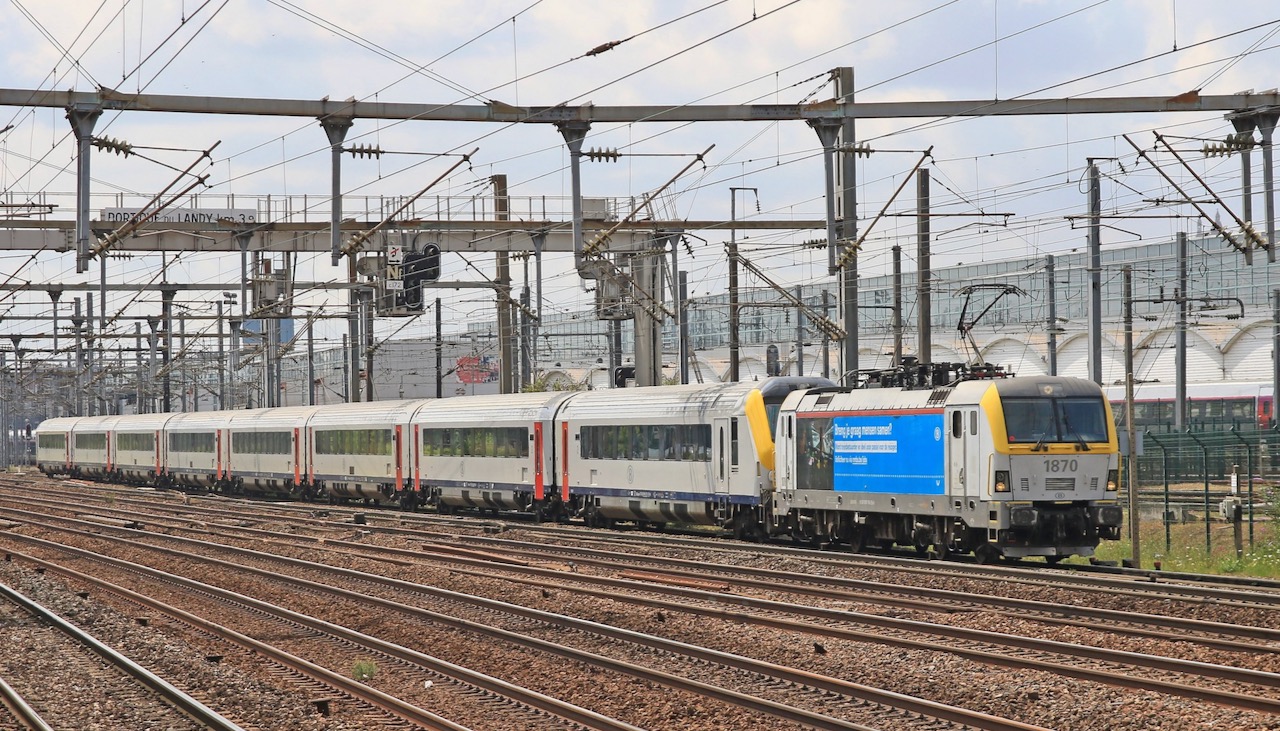
SNCB HLE 1870 passes Le Landy Technicentre as it heads out of Paris on the evening of 24th July with the first commercial operation of L'Eurocity 73 the additional SNCB Paris – Brussels service for the Paris Olympics. Photo: Christophe Masse.
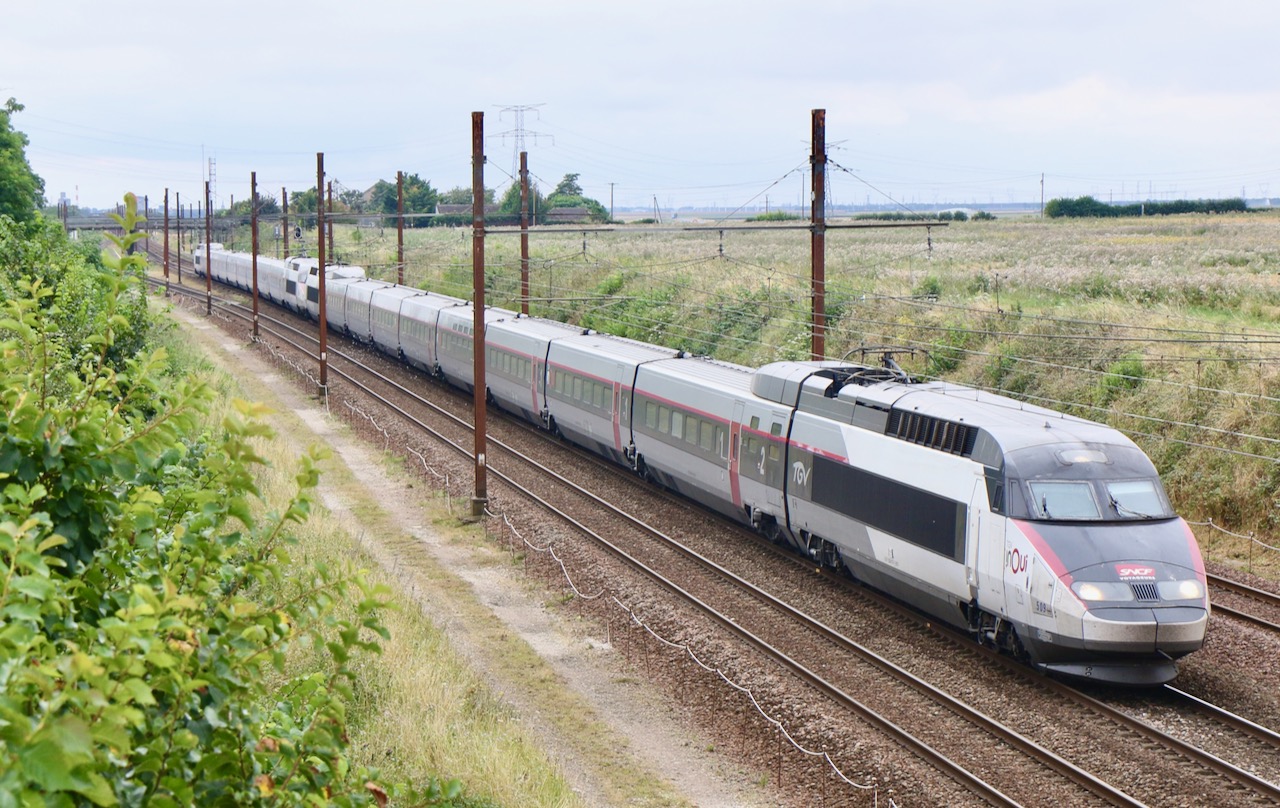
Early on the afternoon of 26th July dual voltage TGV Reseau sets 509/513, are seen on POLT heading towards Paris having just passed the halt at Château-Gaillard north of Les Aubrais with TGV 5440 Bordeaux – Strasbourg. It left Bordeaux 45 minutes late, and did not serve Massy-TGV. It was 2 hours 50 minutes late at Marne-la-Vallée and 3 hours late at Strasbourg. Photo: Georges Turpin.
Arson hits LGV routes
Clearly aimed a disrupting the Olympics opening day, the attacks on three LGV signalling centres were carefully chosen to cause maximum upset to rail services, suggesting a thorough knowledge of the network. Substation 17 at Arrou, close to the Courtalain junction of the LGV Bretagne and Atlantique routes, was damaged by fire as were electrical equipment cabins elsewhere, and power and fibre-optic signalling cables severed. Cables were burnt and cut at Croisilles on LGV Nord, where the Arras contournement branches off, and at Pagny-sur-Moselle where trains leave LGV-Est to serve Metz, Luxembourg and Nancy. A fourth location was targeted, Vergigny in Yonne département, at the intersection between LGV-Est and the PLM classic route east of Laroche-Migennes. Here SNCF maintenance staff disturbed would-be saboteurs at around 01.15 and thus foiled the attack.
All services were initially suspended on LGVs Nord, Est and Atlantique, then trains started to operate via the parallel classic lines, with extended journey times leading to later cancellations as train and staff diagrams were disrupted. SNCF said that up to 250,000 passengers had been affected, many of them heading for the Olympics. Hundreds of SNCF Réseau staff were quickly mobilised to undertake remedial work, which was described as ‘very complicated’ given the nature of the severed cables.
LGV Est trains were able to resume running at about 10.30, with delays of up to 40min, and were back to normal by the end of the day. At Paris Montparnasse, few trains ran until the afternoon and then only one-third of scheduled TGV departures.
Eurostar London – Paris trains were able to run via the classic route but the extra journey time of 1h 30 led to cancellation of about 25% of the timetable throughout the weekend. Some Paris passengers were transferred to Brussels trains for a TER connection at Lille. SNCF hoped services would return to normal on Monday 29th, except for some work on LGV Est continuing into Tuesday. With services disrupted throughout the weekend, some 800,000 passengers are estimated to have been affected.
SNCF Réseau staff tackle the complex job of repairing severed fibre-optic signalling cables. Photo: La Dépêche.
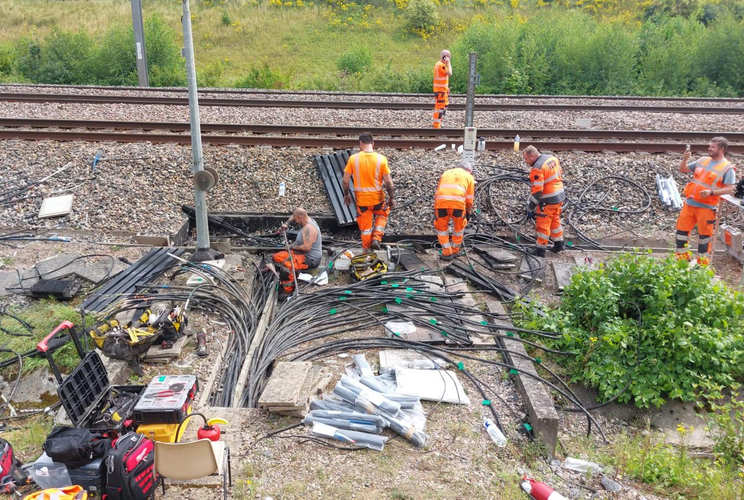
Spain’s case against Ouigo
Central to the complaint will be whether Ouigo’s actions contravene regulations governing liberalisation of the European rail market. Puente has repeatedly questioned Ouigo's pricing policy, which he believes would be impossible without the financial backing of the French state, SNCF being a public company. ‘Competition between operators [RENFE, Ouigo and Trenitalia’s Iyro] must be fair’ he said, ‘and allow the three companies to make a profit, or at least not to suffer losses’. Obstruction by SNCF of RENFE’s proposed operations in France was not mentioned, but ill-feeling continues to impair relations between the two operators.
Competition has lowered average ticket prices by about 40%, and raised patronage by 20 to 50% according to route. In a challenge to its competitors, RENFE introduced Superprecios fares on AVE, Avlo and other long-distance trains from 22nd July to 8th September. The lowest fare on budget Avlo trains will be €7, with €18 tickets on sale for Madrid – Barcelona AV journeys where Ouigo’s best fare is €9.
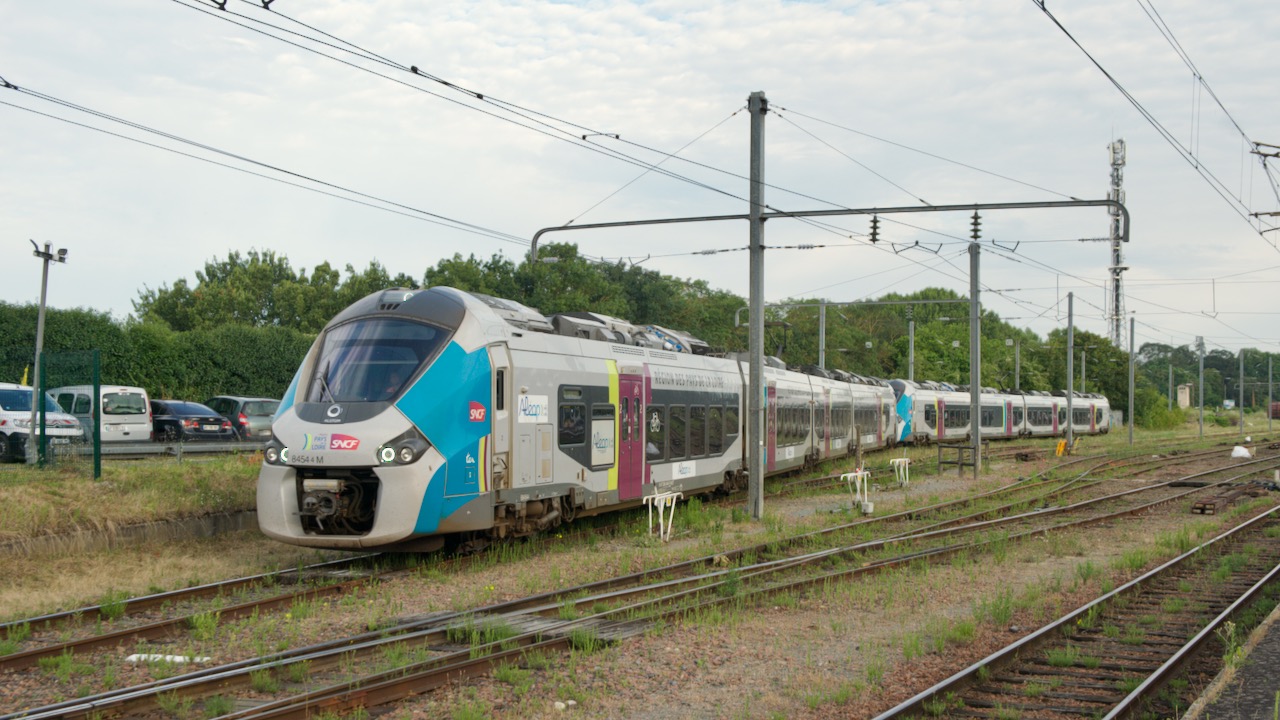
B 84544 leads a pair of bi-mode four-car Régiolis units out of the yard at Saumur on the 18th July with the stock for the summer TER 859087 09.05 Saumur – Les Sables-d'Olonne 'Train des Plages' the only regular passenger train on the section between Bressuire and La Roche-sur-Yon. With modern rolling stock, convenient timings and discounted tickets it is an example of TER growth in recent years.
TER growth drives CPER funding
All régions reported increased patronage of their TER services in 2023 (January to October), Occitanie being in first place with a 20% rise over the same period in 2022. Elsewhere, growth ranged from 2% in Bourgogne-Franche-Comté to 15% in Grand Est and PACA. Except for Hauts-de-France, every région has seen significant growth compared with pre-covid 2019, especially Bretagne up 46%, Occitanie 44%, Pays de la Loire 39%, and Nouvelle-Aquitaine 26%.
For many, the challenge now is to build on these figures despite rolling stock shortages and sometimes indifferent performance. Coping with extra traffic generated by the summer-only youngsters’ PassRail, plus the boom in accompanied bicycles, will be another test. Several régions reached agreement in June on transport funding under their updated 2021-27 State/Région Contract-Plan (CPER) arrangements. Projects mentioned are not exclusive, though some are listed that were not originally envisaged.
Pays de la Loire. Having seen significant growth of 44% between 2019 and 2023, and a further 12% growth in the first three months of 2024, the région plans to increase services by 67%, an additional 300 trains a day, by 2032. With a budget of €1 billion the key elements will be an order for 40 new trains (estimated at €500 million) and the construction of two new maintenance depots at Nantes (Grand-Blottereau) in 2027 and Le Mans in 2031. €133 million has been allocated to the creation of a regional metropolitan express service (SERM) around the metropolis of Nantes and the agglomeration of Saint-Nazaire providing a multimodal offer (train, tram, coaches, bus, bicycle, carpooling), with a TER service every half-hour at all stopping points. The TER will continue to be opened up to competition with expressions of interest requested in July for the the Le Mans 'etoile', for an award of contract in 2026.
Nouvelle-Aquitaine. €1.5 billion (of which €940 million from the State) is allocated to rail out of the roundly €2 billion earmarked for mobility projects. Money has been found to keep Agen – Périgueux going until a major upgrade can be undertaken in 2027, and there is a new proposal for improvements to the Bordeaux – Sarlat line. Local officials were delighted that reopening throughout of Angoulême – Limoges has been included in the CPER, with €31 million earmarked for studies and initial work on the €200 million project (which is otherwise unfunded). Upgrading of the northern section of the Limoges – Poitiers line starts in December, continuing for 18 months, to be followed by renovation of the southern portion in 2028. There is also €20 million for resignalling Limoges – Ussel starting in 2026 or 2027. Completion of this year’s programme of infrastructure works will be followed by track renewal between Bayonne and Hendaye; reinforcement of OHL and power supply on the Arcachon line to support increased service under Bordeaux’s SERM plans; relaying between La Réole and Lafox (Bordeaux – Agen line); and sleeper replacement between Tulle and Montaignac. Routes into Limoges will have extra trains: an earlier arrival from Saillat and a later evening departure, plus two more A/R Limoges – Eymoutiers. There will also be two additional Poitiers – Montmorillan A/R (four on Fridays).
Bretagne. Some 75% of the €682 million (€233 million from the State) Bretagne mobility funding will be spent on rail including renewal of the Redon – Quimper, Auray – Quiberon, Guingamp – Carhaix and Pontivy – Saint-Gérand (freight) lines as well as studies for reopening between Morlaix and Roscoff. Links to the port of Brest will be augmented and that to Lorient port will be reinstated. Further funding is provided for studies of the proposed Rennes – Nantes LGV and its connections to the Redon – Quimper route.
Normandie. €862 million (€330 million from the State), of which €585 million goes to rail. Preparatory work for Rouen’s SERM network will absorb €136 million, including reopening the 6km to Louviers (see April News). Other rail projects are allocated €450 million. Infrastructure modernisation includes studies for installation of ERTMS, further measures to counter the effects of climate change, and more fencing to reduce the incidence of trains hitting animals. €93 million will fund further work between on the Granville line, €40 million for Mézidon – Alençon upgrading, €61 million for Elbeuf – Serquigny, €38 million for Lisieux – Deauville, and €16 million for Lison – Dol de Bretagne. Freight plans include development of multimodal terminals, new private sidings and renovation of the Motteville to Saint-Valéry-en-Caux line (32km).
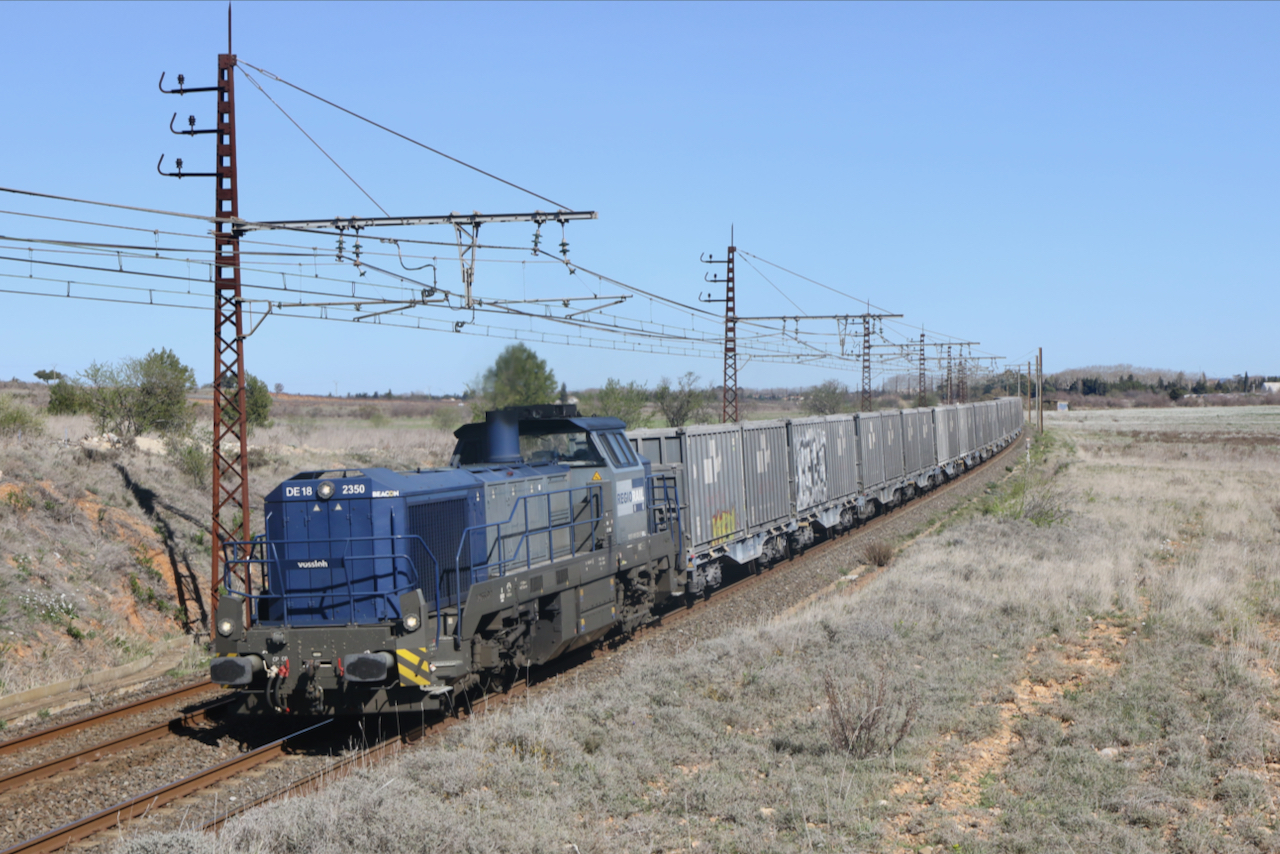
RegioRail expands
Private freight operator RegioRail continues to expand. Above, on 13th March a RegioRail Vossloh DE 18 is seen at PK 380 between Lézignan-Corbières and Moux with 76666 Sète – Tonneins, conveying clinker for use in the cement industry. The use of DE 18s was temporary during a re-organisation of RegioRail's fleet. Formerly a Class 77 working it is now being operated with EMD Class 66s leased by RegioRail from DB Cargo. Photo: Georges Turpin.
This year RegioRail has gained two major contracts with Novatrans following Fret SNCF’s obligation to withdraw from certain flows, taking over the Valenton – Avignon – Perpignan (900km) intermodal service in January (see April News), followed by Valenton – Miramas (750 km) from 1st July; both operate five days a week. RegioRail has been able to handle this rapid expansion thanks to hire of 12 Class BB 27300 electric locos from Beacon Rail Leasing.
Supermarket chain Carrefour has begun receiving shipments of mineral water by rail from the Danone Waters hub at Ambérieu. A weekly train of seven bogie wagons operated by RegioRail for ID Logistics delivers pallets of bottled water to Carrefour’s distribution centre at Grans near Aix-en-Provence which supplies 130 supermarkets. Though there are several bottled water hauls on rail, this is the first direct to a supermarket distribution warehouse. RegioRail has been hauling Danone traffic since 2015 when it won a contract to move mineral water from the source at Publier near Évian to the Ambérieu depot. In 2021 it took over from Captrain France a service from there to Miramas, again for Danone. Representatives of Carrefour, Danone, ID Logistics and RegioRail met the first train at Grans on 24th June.
Photo: La Provence/JZ.

Flexy for Autun
Preliminary works on the 14km branch will see removal of signalling, pointwork and other lineside equipment that might impede operation of the road/rail wheels. Nevertheless, passing places can be provided if patronage demands more than one car in service. On reopening, there will be up to 10 return journeys daily.
Flexy has been developed under SNCF’s Tech4Mobility innovation programme by a consortium of Michelin, Milla Group and the Railenium research institute, with support from Bretagne and Bourgogne-Franche-Comté régions. It adapts automotive technology for lightweight low-capacity rolling stock suitable for rural routes of up to 30km, either already closed or which have too few passengers (300 to 500 daily) for economic operation by conventional railcars. Based on a Renault Master van with the chassis modified to accept Michelin’s patented road/rail wheels, Flexy has capacity for 14 passengers or can be configured to carry cycles or small freight. To pick up and drop-off passengers, the car can leave the rails at level crossings or ‘intersection platforms’ and run on local roads. Battery power provides an operating range of up to 200km with speeds of up to 50 km/h on road and 70 km/h on rail. Photo: SNCF

TELLi. The TELLi project to develop lightweight innovative rolling stock with up to 60 seats received a boost on 18th July when one of the consortium members was awarded a government grant of €3.3 million. Wabtec is contributing its know-how in braking and safety technologies, door systems, capturing and managing energy, and monitoring and informing passengers.
Taxirail derailed. Development of this autonomous lightweight vehicle for use on reopened rural lines has been abandoned. The promoters were unable to raise funds to match a €13.2 million grant from l’Agence de la transition écologique (ADEME).
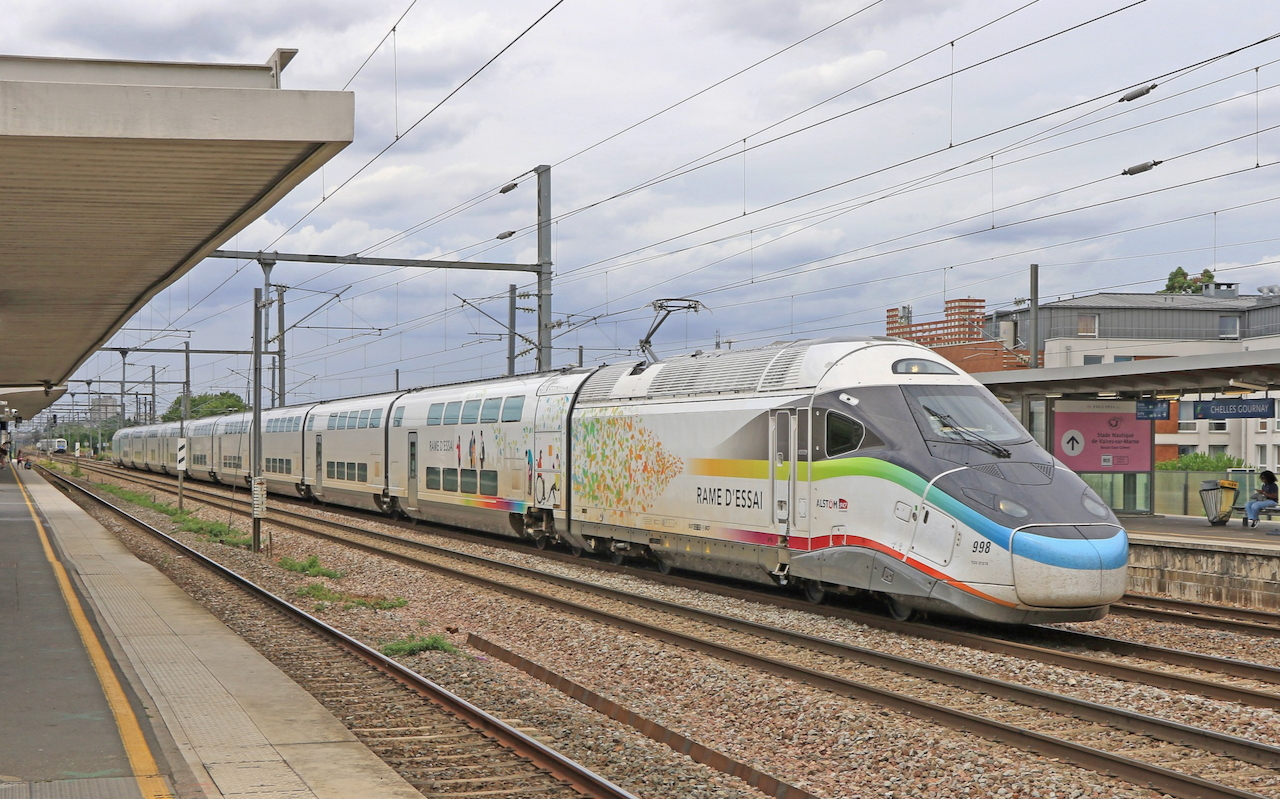
The pre-series TGV Ms (PS) have now been on test for nearly a year and have clocked up thousands of kilometres. At the beginning of July both PS3 (set 998) and PS2 (set 997) were on test between Paris-Est, Châlons-en-Champagne and Meuse-TGV. On the 8th July PS3 is seen passing through Chelles-Gournay en route to Meuse-TGV utilising the front pantograph in emergency mode.
Photo: Christophe Masse.
CP new trains coming
Traffic growth on the urban portion of the Chemins de fer de Provence has confirmed PACA région’s intention announced last year to invest €130 million in eight new trains and other improvements on the metre-gauge route. Announcing the go-ahead on 27th June, the presidents of PACA and Nice Métropole said that patronage had increased by 30% since Lignes d’Azur public transport passes and tickets became valid on CP trains within the Nice métropolitain area in July 2023. Local traffic now accounts for about 75% of journeys (430,000 in 2022). To handle local passengers between Nice and Colomars-LaManda, the four Friday and Saturday late-evening services (hourly from 20.20) are running daily through the summer season.
New trains will be ordered shortly for entry into service by the end of 2027. Costing €56 million, they will be diesel/electric hybrids capable of running on battery power in the Nice urban area. Clearance has already been provided for possible installation of OHL within Nice, but electrification does not figure in the current scheme. With air-conditioning, wifi and better seating, the trains will provide a higher standard of comfort than current stock.
A further €28 million has been allocated for construction of a maintenance depot at Nice Lingostière, €7 million for resignalling to reduce Nice – Colomars headway from 40 to 20min, and €6 million for renovation of stations at Puget-Théniers, Entrevaux, Annot, Thorame-Haute, Saint-André and Digne.
Additional infrastructure works will be carried out to improve reliability of the line in bad weather. Meanwhile September should see the long-awaited start of rebuilding Moriez tunnel (1,195m), closed since its collapse in 2019. This will cost €6 million. Reopening in 2026 will allow trains to run through to Digne once again.
Photo: ©Chemins de fer de Provence.
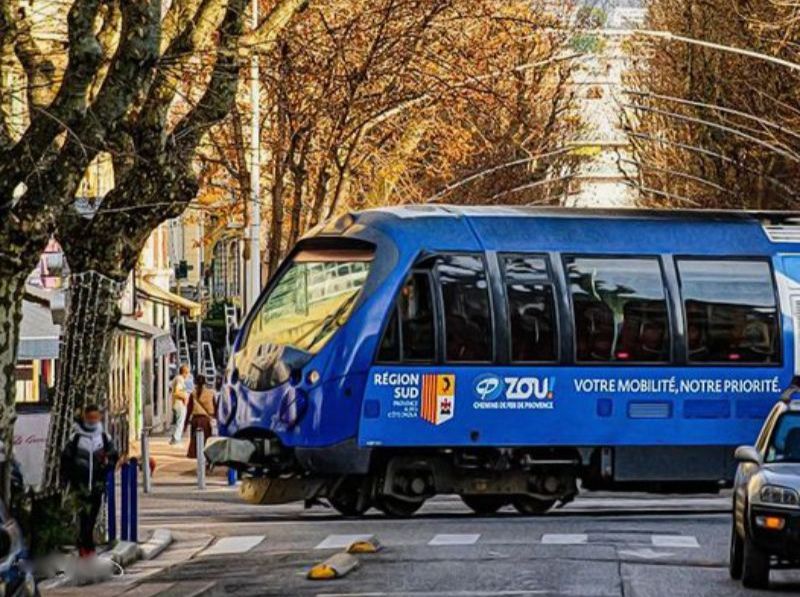
SERM designations
Fifteen city/regions were granted eligibility for public finance of their SERM projects on 27th June, an announcement that was criticised in some quarters as being rushed through as a pre-election ploy. They are: Bordeaux, Chambéry, Clermont-Ferrand, Grenoble, Lille, Lyon, Montpellier, Mulhouse, Nantes, Rouen, Saint-Etienne, Strasbourg, Toulouse, Tours and Lorraine-Luxembourg.
Another announcement had been expected during July, possibly adding 10 more cities to the list, but this was postponed due to government paralysis following the elections. Several proposals (Avignon, Marseille, Nice, Orléans, Toulon, Basco-Landais, Franco-Swiss and Pas-de-Calais) were held over for more detailed examination. See June News for a full list of the schemes proposed.
Lyon. Just before its designation was confirmed, Lyon Métropole decided on 24th June to fund further studies of increased service provision on its busiest TER routes from 2027 as a prelude to full-scale development of SERM. Earlier work had suggested that some off-peak services might be increased to half-hourly or even 15min frequency with better utilisation of existing rolling stock, but that augmenting peak-hour services would not be possible except between Lyon Saint-Paul and Brignais and Perrache – Givors. Now it is hoped that 108 additional daily services can be added in 2027, once assessment has been made of the effect on 59 level crossings and increased passenger flows at the busiest stations, plus the possibility of signalling alterations at Part Dieu for 2TMV so that two trains can occupy the same platform simultaneously.

Viaduc de Chaumont
After a five-week closure for waterproofing of the trackbed, France’s longest masonry viaduct is scheduled to reopen on 11th August. The viaduc de Chaumont is 600m long, with 50 arches atop two rows of support spans. It carries the Paris – Belfort – Mulhouse line 52m above the Suize valley just west of Chaumont. The stonework has been particularly vulnerable to water ingress and remedial work was necessary in 2016 and 2019. This time, both tracks have been lifted and the entire upper deck relined with waterproof membrane at a cost of €2.1 million funded by SNCF Réseau.
Completion of the work will be followed by two years’ observation to ensure that the waterproofing has been successful. Then further masonry repairs will be carried out so that the pedestrian path along the lower-level arches can be reopened.
During the closure, long-distance trains have been diverted to other routes while local passengers detrained at Bricon, 12km west of Chaumont, where the station closed since 1997 was temporarily reopened, or at Bologne 13km north on the line from Paris via Châlons, for a bus connection to Chaumont. Photo: Ville de Chaumont.
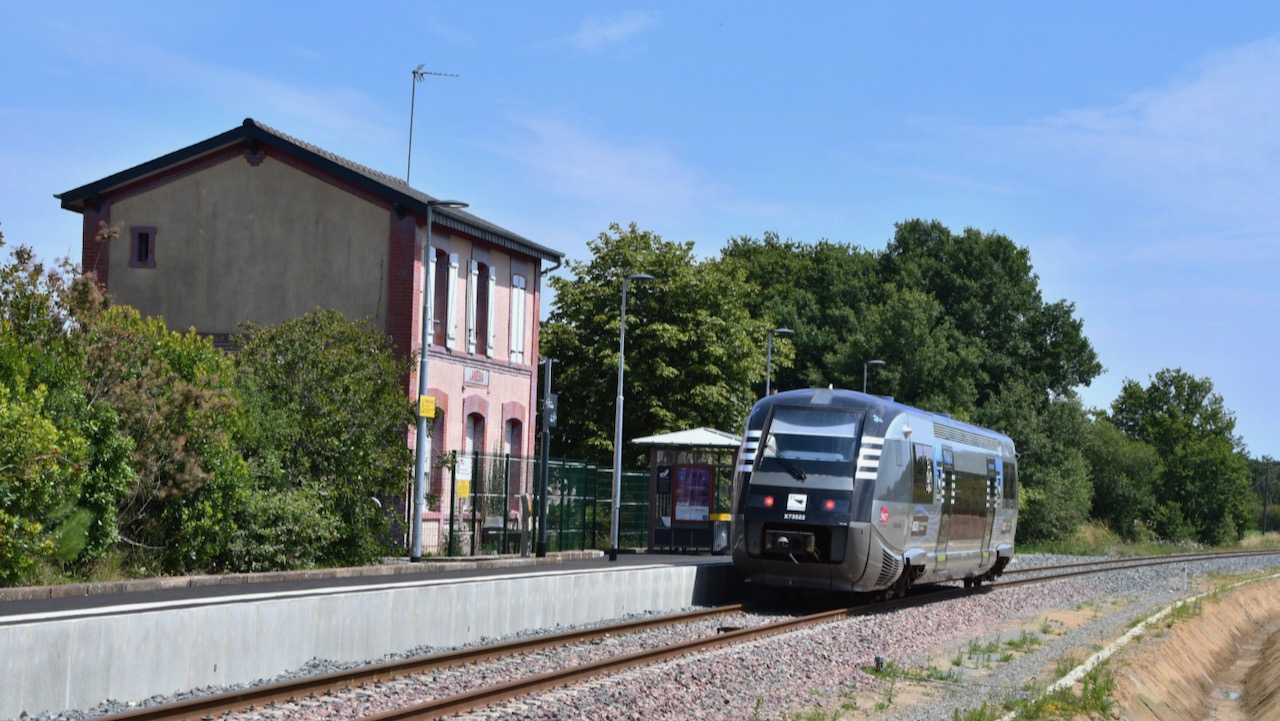
Dinan – Lamballe running again
The €53.8 million rebuilding of this 41km line was completed and service resumed on 7th July, though with only three daily A/R instead of the seven that were expected (see April News). All run to and from Saint-Brieuc but none connects at Dinan with trains eastwards to Dol-de-Bretagne. A further two A/R will be added when the school year starts at the beginning of September. The local passenger group is pressing for eight A/R daily and merging of the two services for through running between Dol and Saint-Brieuc.
Above. X 73522 with TER 854176 13.20 Saint-Brieuc – Dinan at Landébia on 18th July. With maximum line speed now raised to 100km/h, journey time has been cut by up to 17min.
Photo: David Haydock.
Photo: Ouest-France.
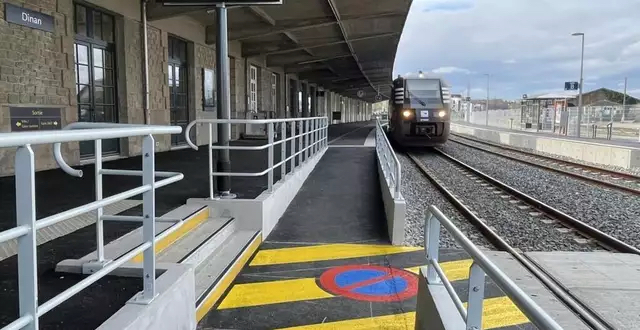
Part-Dieu progress
Lyon’s rebuilt Part-Dieu station is emerging after 10 years’ work, with the new Halle Béraudier (see below) opened on 25th June enlarging the concourse area by 10,000m2 and providing 20 shops and food outlets on three levels with a large terrace on the second floor. Light streams through the roof which comprises multi-coloured strips which filter the sun’s rays to help cool the interior.
Construction continues of the lower square entrance and exterior public space facing boulevard Vivier-Merle prior to completion of its dramatic steel canopy next spring. Beneath the new frontage will be a cycle park with 1,300 spaces reached by a circular ramp, a taxi rank, passenger drop-off point, and metro access.
The two sides of the station will be connected by an underpass reserved for pedestrians and cyclists who will no longer need to pass through the concourse itself; this opens next month.
The €135 million project to replace obsolete buildings, declutter and enlarge the concourse, and provide more green space, is part of a larger scheme to develop the station as a multimodal interchange (PEM) and improve the passenger experience. Dating mostly from the 1970s and built to handle 35,000 passengers daily, the station now sees 130,000 on weekdays; SNCF expects that figure to double in the next few years. Work on the Vivier-Merle side should be completed by the end of 2025, while renovation of the Villette entrance on the eastern side will take place during 2026.
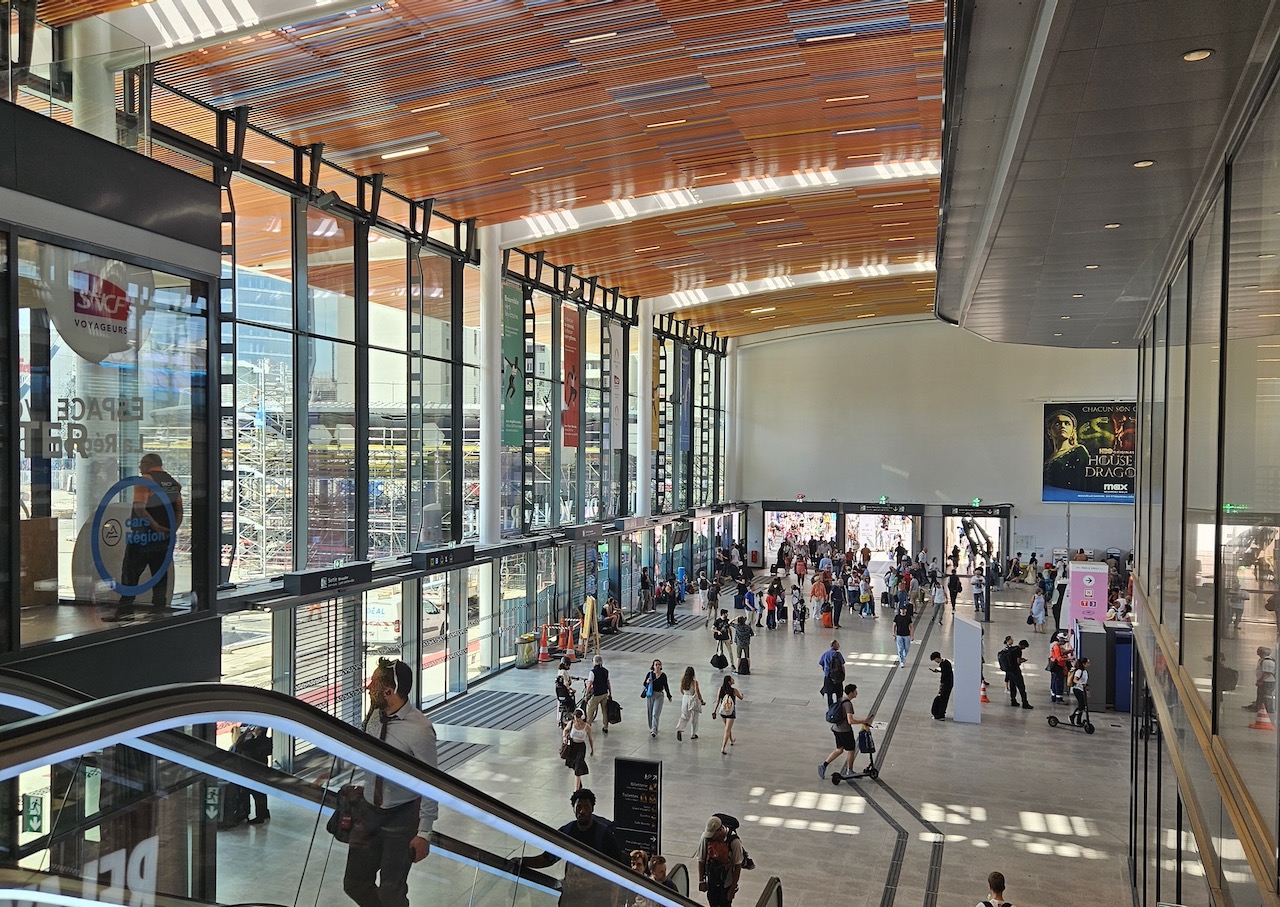
Blanc-Argent upgrade
The Blanc-Argent line is partially closed until the end of August for another major upgrade following the first phase of work carried out last year between Valençay and Romorantin-Lanthenay. This year work is focused on the section between Romorantin and Salbris. Costing €8.8 million and financed by Région Centre-Val de Loire, the work covers replacement of sleepers and ballast over 3.5km, complete renewal of track (rails, sleepers and ballast) at Villeherviers, Selles-Saint-Denis and La Ferté-Imbault stations and repairs to 10 level crossings.
The work will maintain this section for the next 15 years, avoiding speed restrictions and improving reliability. The 56km metre-gauge line operates 125 services a week and carries 700 passengers a day, predominantly students and schoolchildren to Romorantin-Lanthenay. During the works, trains continue to run between Valençay and Romorantin, with bus connection thence to Salbris.
Photo: Rémi Région Centre-Val de Loire.

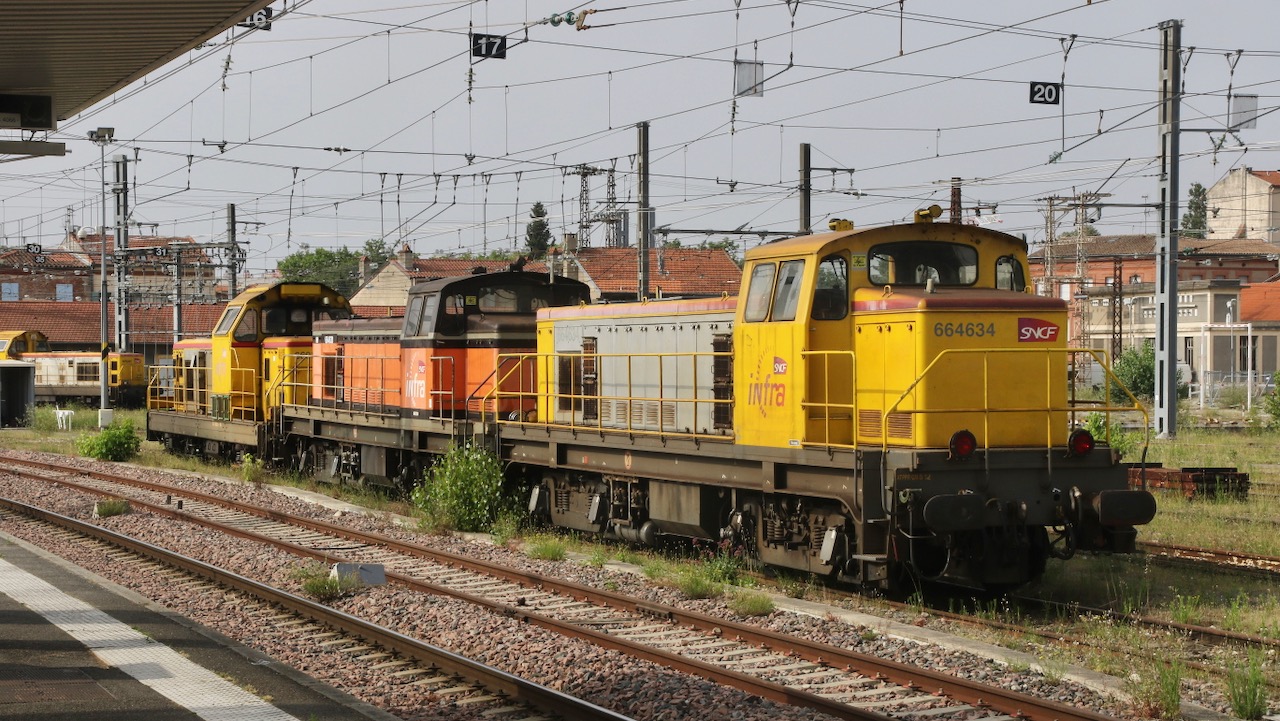
With a combined age of 183 years, three members of the Infra fleet, Nos BB 64634 (ex 63831, December 1963), BB 64631 (ex 63402, November1959!) and BB 69310 (ex 66310, December 1967), await their next duties at Toulouse on 28th June. Photo: Georges Turpin.
EU funding for Lyon – Turin link
On 17th July the European Commission announced €7 billion of grants under the Connecting Europe Facility, with 80% going to rail projects. The announcement provides €765 million towards the main construction work and includes a further grant of €64.6 million of the €70 million requested to undertake detailed pre-project studies of the route of the French section of the Lyon – Turin link between Lyon and Saint-Jean-de-Maurienne.
This study programme should be launched at the beginning of 2025 under the leadership of SNCF Réseau, likely to take three years before start of the first underground reconnaissance work. It will focus on the route of the so-called ‘Grand Gauge’ scenario, the most favourable alignment for rail freight, chosen by a majority of the local authorities concerned.
Financing of the €100 million French share of the studies is split: State (€59.1 million), Auvergne-Rhône-Alpes région (€33 million), Département of Savoie (€3 million), Département of Rhône (€1.5 million), Grenoble area mixed mobility union (€1 million), Grand Annecy (€1 million), Grand Chambéry (€0.45 million), Grand Lac (€0.3 million).
Map: Transalpine.
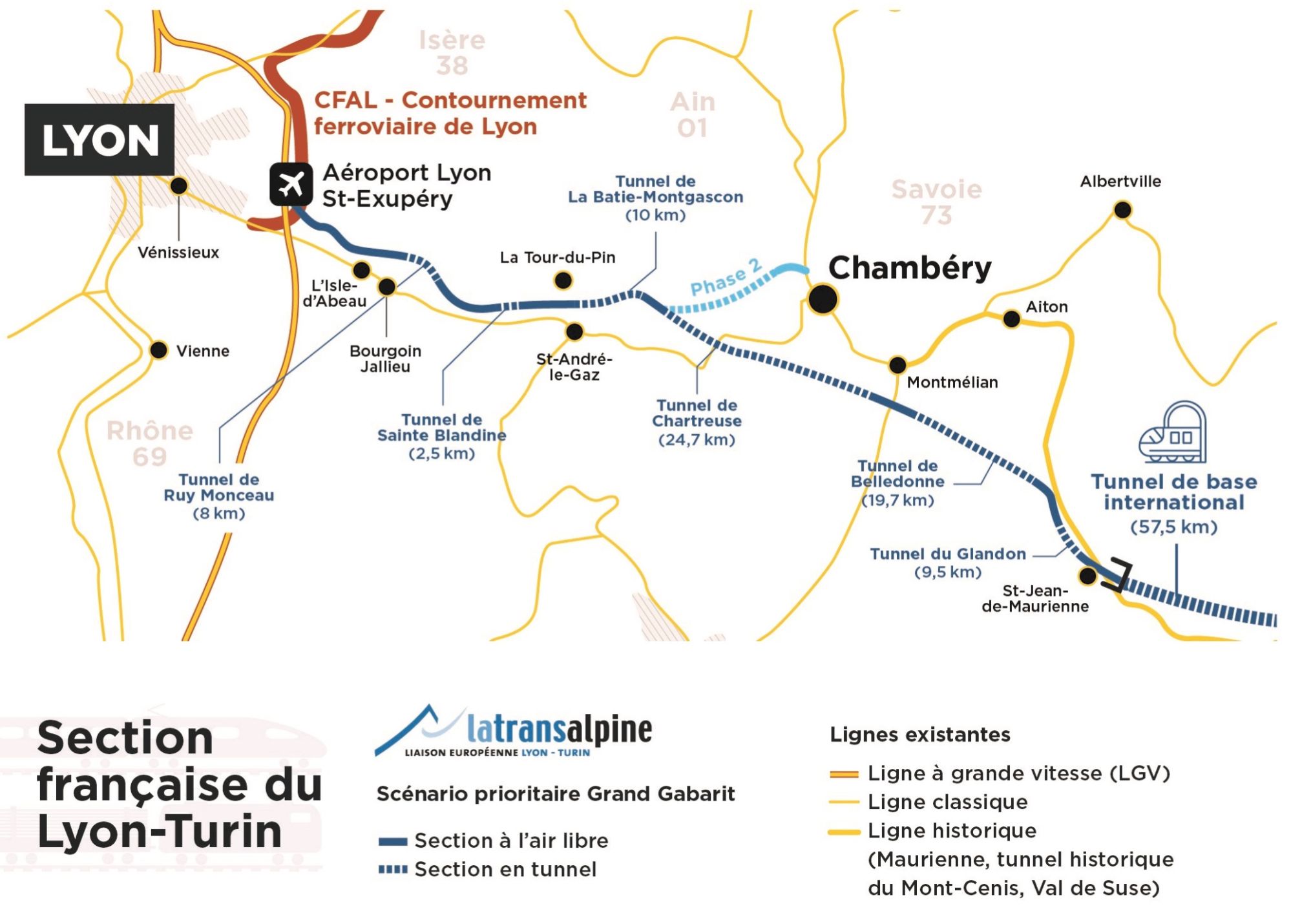
Maurienne Valley. Restoration work is running behind schedule and SNCF now says December reopening depends on there being no further delay due to unforeseen events. During the summer period until 25th August, replacement buses are using the Mont Cenis road tunnel (normally closed for works) to provide a 30min link between Saint-Jean-de-Maurienne and Modane, saving an hour over the drive to Oulx in Italy. When through service does resume, as a result of local pressure Trenitalia’s two daily trains will stop at both Saint-Jean-de-Maurienne and Oulx, improving trans-frontier connections and providing a direct link to and from Lyon.
New accord for Canfranc reopening
Nouvelle-Aquitaine president Alain Rousset and his Aragon counterpart Jorge Azcón Navarro signed an accord on 16th July reaffirming their commitment to reopening the 33km missing link between Bedous and Canfranc to re-establish the route from Pau to Zaragoza as a freight artery. Accompanied by maires of communities along the line on both sides of the border, they met at the mouth of the 7.9km Somport tunnel which is currently used as an evacuation route for the parallel road tunnel.
Rehabilitation of the rail tunnel to modern standards would constitute the major infrastructure work of the reopening project, now to be known as the Goya line after the Aragonese painter.
Photo: SudOuest/LH.
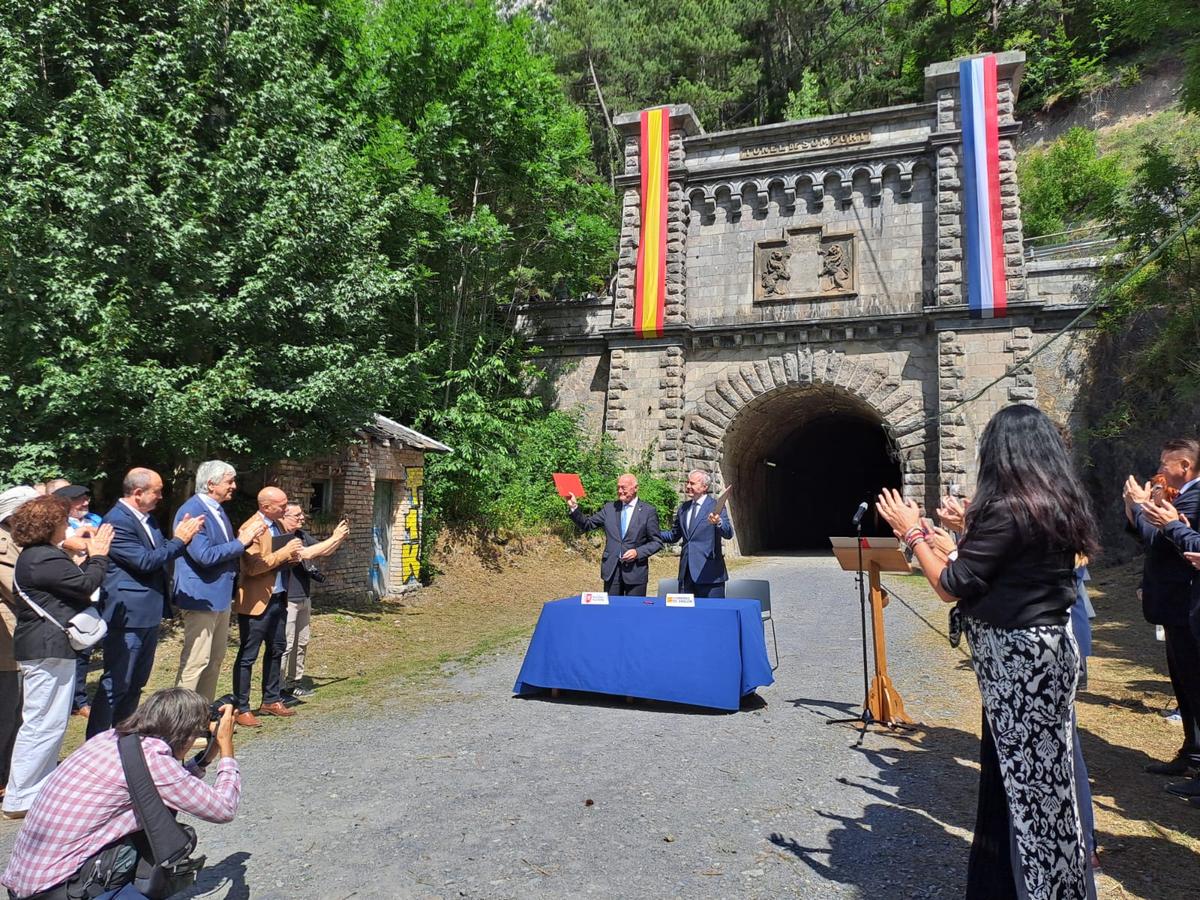
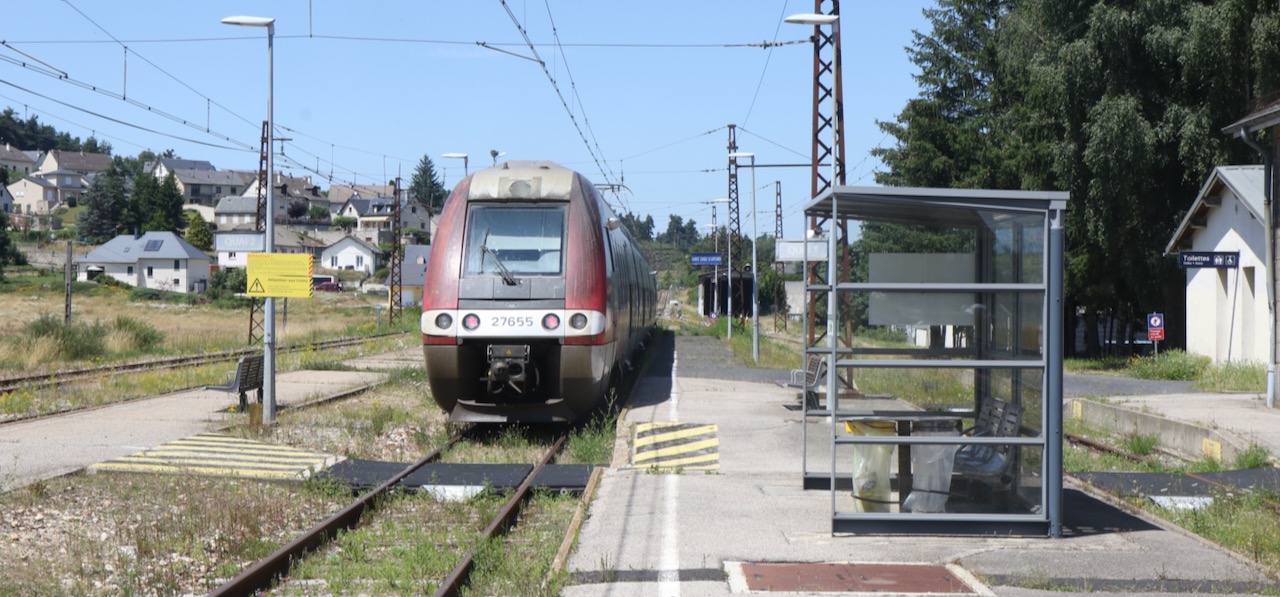
Aubrac Summer
With storm damage repairs now complete at the southern end of the line, the section between Saint-Chély-d'Apcher and Neussargues remains closed until 1st November for track refurbishment. Costing €46 million, the eight-month suspension will see 27km of track renewed with new rail, 46,000 sleepers and 40,000 tonnes of ballast. Two sets of points will also be replaced, while eight level crossings and four bridges will be rebuilt.
As during previous closures, passengers seeking to get to Clermont-Ferrand and Paris are taken by coach over the suspended section, serving the one intermediate station at Saint-Flour. This is a far cry from the days of the Aubrac, the through Béziers – Paris train replaced in December 2007 by an MU running only as far as Clermont, or at times terminating at Neussargues with onward connection by a train from Aurillac. This retains its IC status as one of the seven daytime TET routes nationwide, receiving a subsidy of around €25 per journey, and is the only passenger train running beyond the Occitanie boundary at Saint-Chély. On 18th July Occitanie TER AGC Z 27655/6 has arrived at Saint-Chély from Béziers and waits in the sun for the connecting coach from Neussargues before departing as IC 15645 15.39 Saint-Chély to Béziers. Photo: Georges Turpin.
Occitanie Rail Tour
The pass is available for between two and six days at a cost of €10 a day. There are no child rates but children under 4 travel free. In addition to TER travel across the Occitanie network the pass can also be used on liO services to Agen, Pau, Brive, Avignon Centre, Tarascon-sur-Rhône and Clermont-Ferrand.
The pass is also valid on coach services operated by SNCF and allows travel on the liO coach network at €2 per journey.
Further details and to buy online via this link

News in Brief
Nevers roundhouse demolition refused. An application by SNCF to demolish the roundhouse at Nevers has been refused by the prefecture. The decision took account of the heritage value as this is the last of three roundhouses originally at the depot, the lack of any study for protection and re-development, and the opportunities for conversion.
Further Mohon dispersals. Former Toulouse residents BB 8616, BB 9301 and BB 9337 were all moved from Mohon to Vierzon during July. BB 8616 will stay at Vierzon in the custody of CFTST while the BB 9300s are destined for ACPR 1126 at Toulouse, which currently have no accommodation for them.

La Rochelle. Following restoration of the station’s exterior, roof works started on 24th June with removal of the lantern structure from the top of the 45m-high clock tower. This will undergo restoration whilst the main roof glazing is cleaned and replaced. The project will be completed in 2026. Photo: SNCF Gares et Connexions.
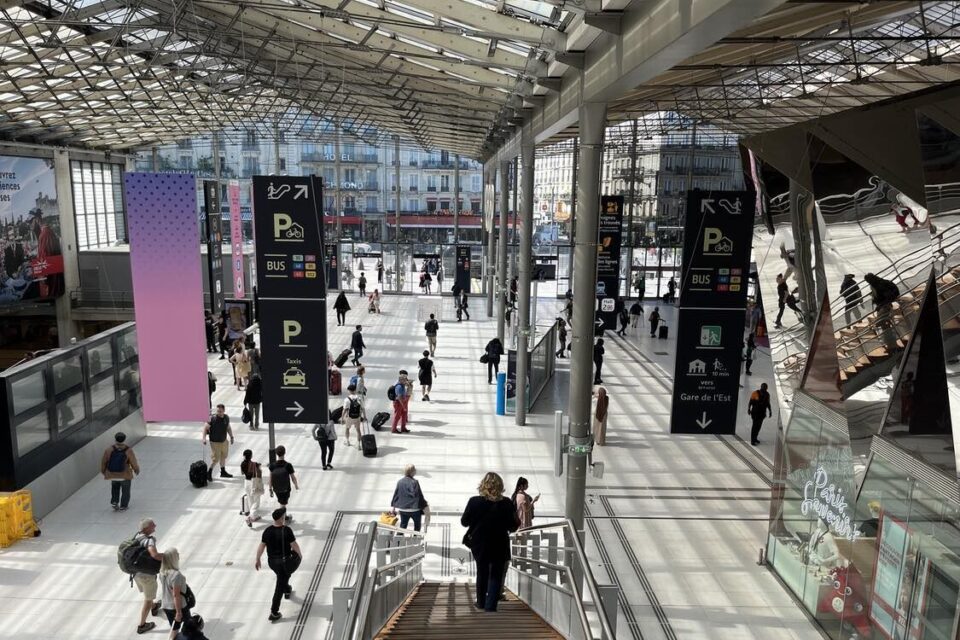
Paris Gare du Nord. The €50 million Horizon 2024 phase of the modernisation programme (see September 2023 News) was opened on 25th June, with the station ready to handle the Olympics crowds. Better signage and larger public areas ease passenger flow; new escalators link the main line and suburban concourses. Taxi access has been reorganised and the vast 1,186-space cycle park is open. In the autumn, more ticket machines will be provided to cut queueing, while further work is planned next year to improve the cramped areas devoted to Eurostar services. Photo: ActuParis/DG.
Cherbourg port. Work is underway on restoration of the 2.5km link from the national network into the port of Cherbourg, out of regular use since 2008, in preparation for start of Brittany Ferries’ rolling motorway service to Bayonne. During the week beginning 8th July the 33m-wide D901 level crossing close to the station, used by 30,000 vehicles daily, was rebuilt to current standards.
Montluçon – Gannat. The proposed Imerys lithium mine at Échassières has been designated as of intérêt national majeur and its development is to be fast-tracked. Up to 34,000 tonnes of mica per year would be dispatched over the Gannat – Montluçon line for processing at La Loue, north of Montluçon, where the lithium would be extracted. On the passenger front, AURA région is to apply to the government ‘before the end of the year’ for TET status to be granted to the proposed Lyon – Bordeaux IC service. Both schemes depend on upgrading between Montluçon and Gannat, as yet unfunded (see July News).
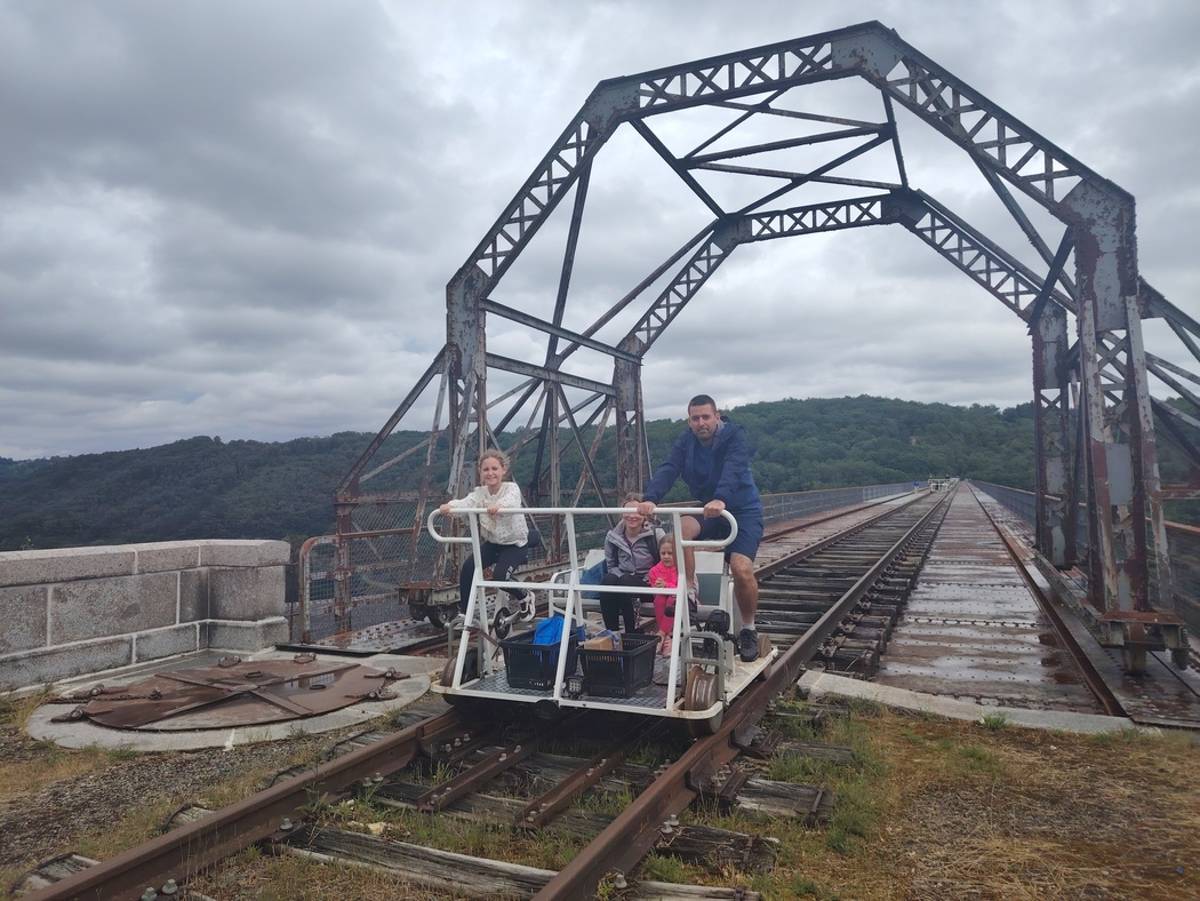
Fades vélorail. Now in its fifth season, the vélorail operated from Les Ancizes by the local Communauté des Communes offers unique access to the viaduc de Fades on the closed line between Lapeyrouse and Volvic. Next year, it plans to introduce all-terrain electric bikes, gps-guided to offer views of the 92m-high viaduct from otherwise inaccessible locations. Remedial work on the viaduct itself would allow use once again of the walkway beneath the decking.
Photo: Vélorail Électrique des Fades.
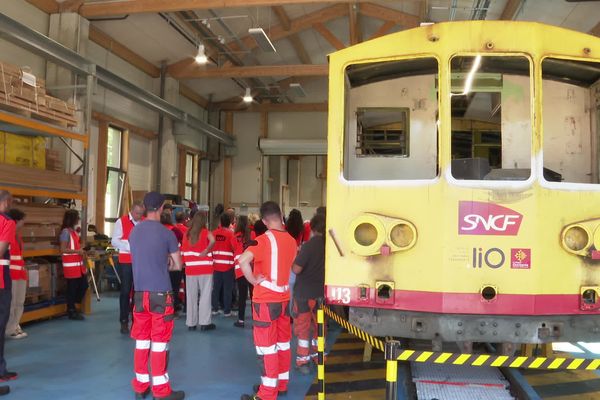
Train Jaune. The new maintenance depot at Villefranche-Vernet-les-Bains was commissioned last month. All work on the trains will now be carried out there rather than at Béziers as previously; 12 additional staff have been recruited. Further modernisation of the 24 cars will equip them with LED lighting and USB sockets for next season. Photo: ©FranceTV.
SNCF/DB. After eight years of co-operation, SNCF and Deutsche Bahn have signed a new agreement strengthening their partnership in sharing technical and digital know-how.
Villeneuve. Work started in June on the €685 million modernisation of Villeneuve-Saint-Georges Technicentre where Régio 2N and NG trains for RER Line D and Transilien Line R are maintained. A new seven-track depot will handle heavy maintenance of both types of train, while major changes will be made to existing facilities to cope with NG stock.
Beynac. Dordogne département, Nouvelle-Aquitaine région and SNCF signed an agreement on 22nd June for reopening of Castelnaud-Fayrac station between Le Buisson and Sarlat as part of revised proposals for a road bypass of nearby Beynac, one of France’s prettiest villages. All trains would stop during July and August, for the rest of the year by request at peak hours only.
Forbach. Grand Est région is studying resumption of passenger service between Forbach, Creutzwald, Bouzonville and Thionville (78km) to provide a rail alternative for the 5,000-or-so commuters from the Moselle-Est area to Luxembourg.
Barcelona. From 6th July to 1st September, SNCF is running a third daily Paris – Barcelona A/R, departing Gare de Lyon at 06.38 and Barcelona Sants at 16.04.
Rolling stock finance. The European Investment Bank has released a €400 million grant to the SPIIT rolling stock leasing company jointly owned by Occitanie and Nouvelle-Aquitaine. This is one-third of the €1.13 billion global loan raised by the two régions for purchase of 27 new EMUs, 12 bimode (electric/diesel) MUs and three hydrogen/electric MUs, and will also cover part of the cost of mid-life refurbishment of 97 MUs operated by the two régions. NA plans to call tenders for up to 30 MUs in the autumn.
Grand Est Corail. Transfer of seven Corail VTU coaches from Bourgogne-France-Comté région at a cost of €146,000 has been approved by the Grand Est Commission Permanente. This will allow GE to retire the last compartment stock (VU) from its fleet of 167 Corail coaches.
Bordeaux – Limoges. After a poor record in 2023, when only 81% of trains were on time, SNCF reported 88% punctuality during the first five months of 2024, with cancellations down from 6.3% to 5%. Infrastructure work will be carried out over the coming year, including making all stations between Périgueux and Limoges fully accessible.
Bischheim-Schiltigheim. Proposals to build a TER train maintenance have been abandoned after a sustained campaign by local groups. A site on spare land at Hausbergen freight yard just north of Strasbourg gare has been chosen instead.
Musical chairs. Following the row over SNCF’s ban on large instruments such as double-basses on TGVs, dedicated space has been allocated for a trial period over the summer, enabling musicians to reserve seats close to their instruments. A fee will be introduced if the provision is made permanent.
RENFE. Carried 620,000 passengers on its daily Madrid – Marseille and Barcelona – Lyon trains during their first year of operation, with average occupancy of 82%.
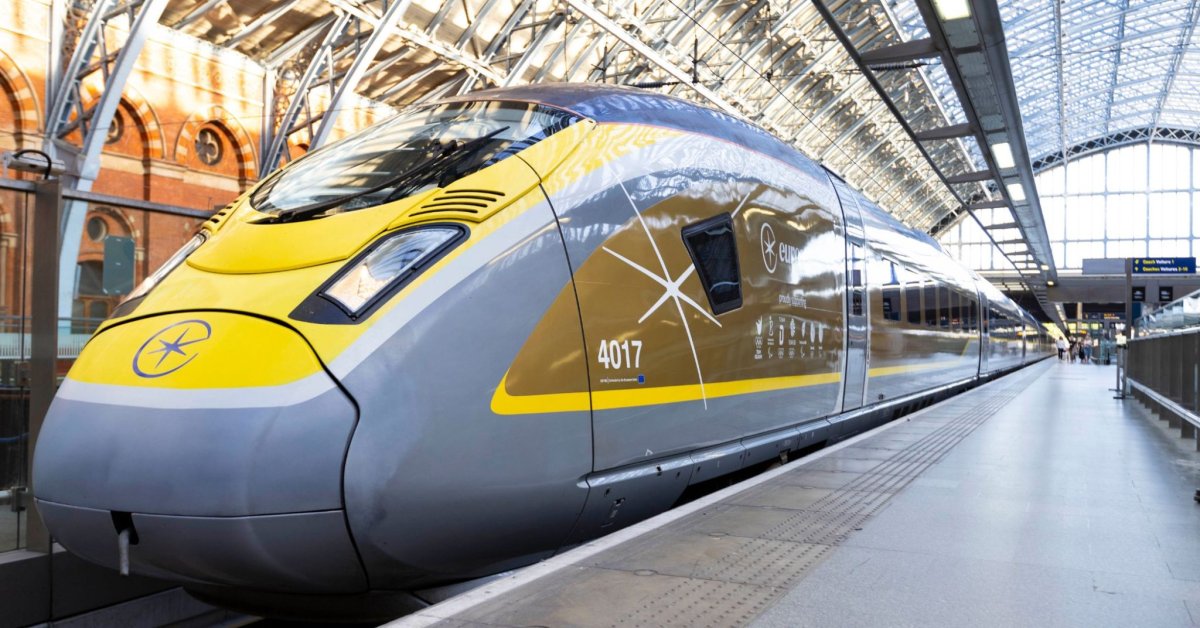
Eurostar. On 25th June unveiled an Olympics gold livery on e320 sets Nos 4017/18 and 4027/28; 2 million London – Paris passengers are expected during the Games period. Booking opened on 9th July for Eurostar’s ski train from Lille to Bourg-Saint-Maurice, running this winter every Saturday from 21st December until 1st March 2024, returning the following morning. A London connection is provided in each direction. Photo: Eurostar.
Moissy-Cramayel. An €8 million modernisation of the Geodis logistics centre was inaugurated on 24th June. The complex handles SNCF Voyageurs’ supply chain, storing and distributing around 150,000 components from 1,000 suppliers to SNCF’s 35 Technicentres.
Espresso Riviera. Stylish travel returns to the Côte d’Azur this month with weekend trips between Milan and Nice by FS subsidiary Treni Turistici Italiani using preserved rolling stock. From 3rd August to 1st September Espresso Riviera departs Milan on Saturdays and Sundays at 07.35 for Nice arrival at 13.58, returning at 17.12 to arrive Milan at 23.40. The train will continue during September, but only running as far as Vintimille. Single fares start at €44.50 second class and €59.50 in first, where passengers are served breakfast and dinner in the restaurant car.
Rodez. Trains to Brive were expected to resume on 5th August following restoration of the track near Nuces (see July News), limited to 20km/h at the work site for a further two months whilst 44 piles are driven to consolidate the slope above.
PLM overhead upgrade. A four-month partial closure between Dijon and Laroche-Migennes starts on 12th August for replacement of overhead equipment between Aisy and Ancy-le-Franc (14km). SNCF’s OLE factory train will install 565 new masts along with other works representing investment of €18.3 million. Bourgogne-Franche-Comté’s Mobigo TER service will not run over the affected route between 09.30 and 17.30 on weekdays.
Hybrid moves to Grand Est. Following trials in Occitanie and Nouvelle-Aquitaine, the electric/diesel/battery hybrid Régiolis MU began four months of commercial operation between Strasbourg and Sarreguemines on 15th July.
No takers for Train de Primeurs
The government’s second call for expressions of interest in restarting this service in 2026 produced no offers and the 19th July deadline has been extended until 4th September. “This is a very small flow with a very small turnover,” said Fret SNCF, “it cannot be profitable without state aid.” CGT trades union members are reported to have intervened to prevent scrapping of the train’s refrigerated wagons stored at Forbach.
The last fruit and vegetable train from Perpignan to the Paris market at Rungis, formed of the elderly refrigerated wagons, ran on the 28th June. It is planned to re-introduce it in 2026 when the facilities at Rungis have been rebuilt to accept combined transport including HGVs and semi-trailers, and the train can include other traffic. Viia, the SNCF rail motorway operator has won the contract to construct the new terminal, but are forbidden from operating the train as part of the economic discontinuance imposed by the EU for unlawful subsidies.
According to Raphaël Doutrebente, CEO of Europorte and president of the 4F Alliance which brings together all the players in the French rail freight sector: "As long as the rail route between Perpignan and Rungis remains unavailable for rolling motorway traffic, no operator can offer a quality service that would make money". In the meantime the fruit and vegetables will travel by road.
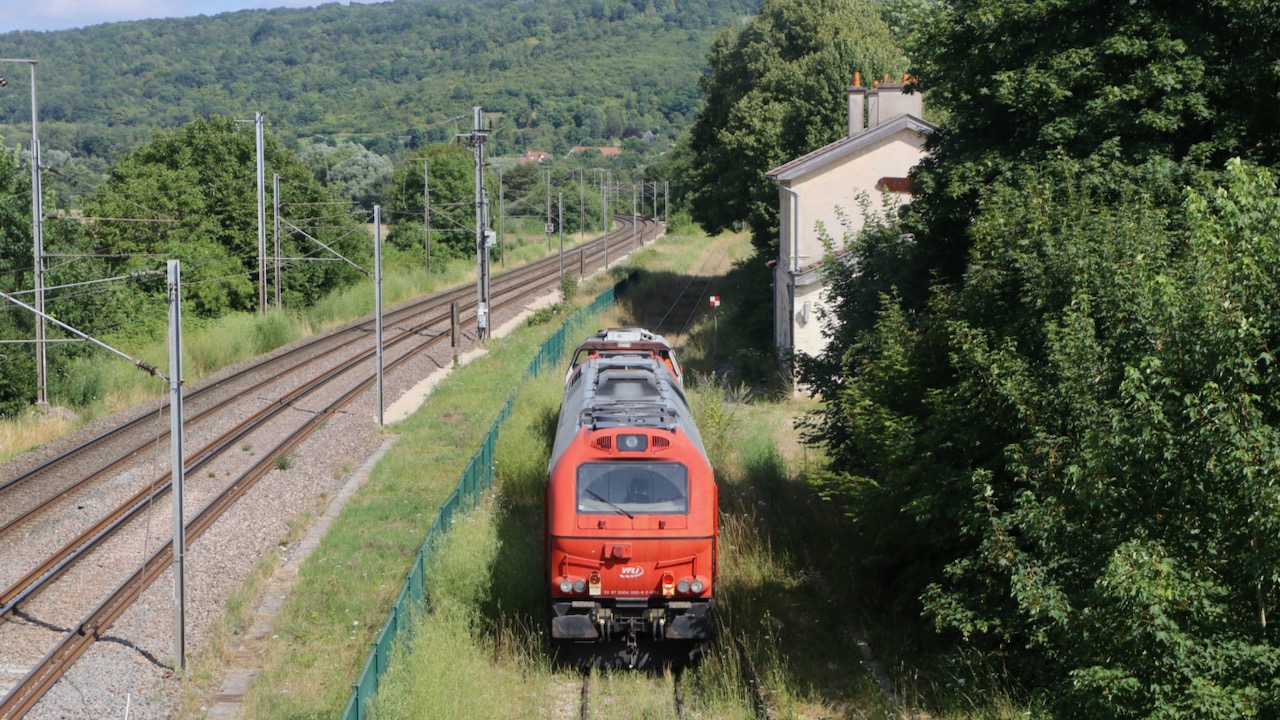
Hold up at Mézy. On 22nd July Captrain E4050, hauled by BB 61734, was in transit from Valenton to the former VFLI workshops at Montmirail for attention. Shortly after leaving Mézy, on the branch to Montmirail, the journey had to be abandoned due to the poor condition of the track, and the little convoy returned to Mézy station where they are seen above, next to the Paris – Nancy main line. Note the carré placed at the platform end. The line was repaired on 24th July. Photo: Georges Turpin.
Serqueux to Gisors withdrawn
Passenger services between Serqueux and Gisors were withdrawn at short notice by Normandie TER and replaced by buses from 22nd July. Introduced some 10 years ago, the service was then subsequently suspended for three years for electrification as an alternative route for freight from Le Havre, and re-introduced in 2021. Average loadings have only been six passengers a train, with many running empty and the service losing €1.7m a year. Freight services continue over the line.
The move has angered local politicians, particularly that only four days notice was given. They argue that more could have been done to promote the service and resolve problems with Île-de-France Mobilities at Gisors. With no through ticketing available, passengers travelling from Serqueux to Paris have a short time to purchase their onward ticket, take the subway to change platforms, and hopefully make their connection to St Lazare.
Nexrail hybrid DE 18
On 24th June leasing company Nexrail unveiled its first DE 18 Stage V Smart Hybrid locomotive at Imateq’s Saint-Pierre-des-Corps works, developed with Vossloh which is building 50 of the class. With an 1,800kW diesel engine and 74kWh battery, the loco can run diesel-free for up to an hour silently and with no emissions. Equipped for ETCS with Level 2 upgrade option, the loco is suitable for operation in France, Belgium, Germany and Luxembourg.
Photo: Nexrail.
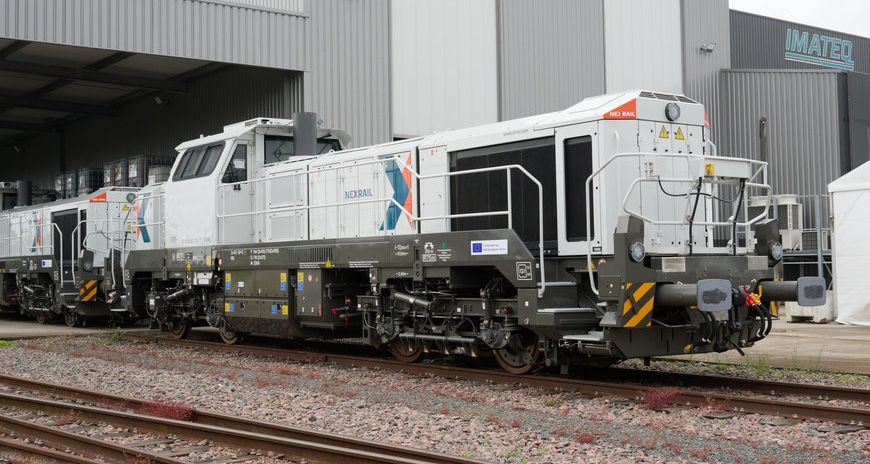

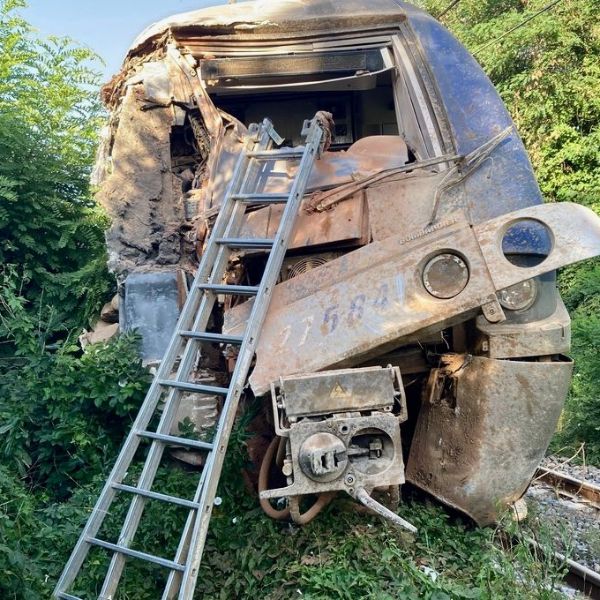
On 24th July TER 877650 06.06 from Villefranche-Vernet-les-Bains to Perpignan ran into a washout at Eus east of Prades. AGC Z27583/84 was derailed and hit a bridge pier before coming to rest. The driver was hospitalised and five of the seven passengers were slightly hurt. Photos: France Bleu/DR.
SNCF climate forum
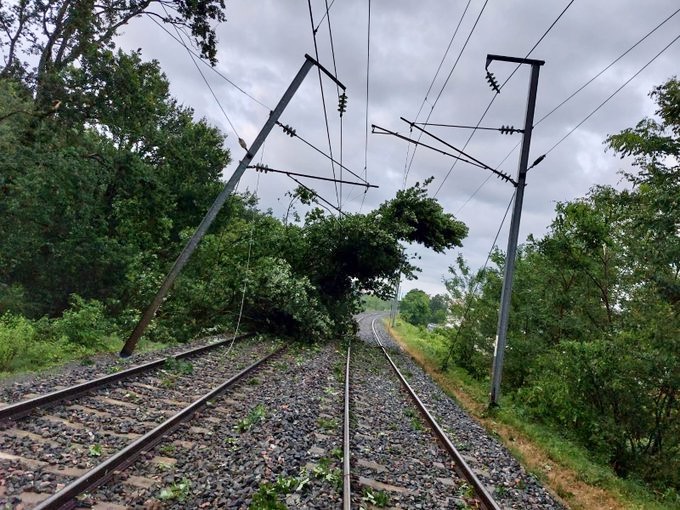
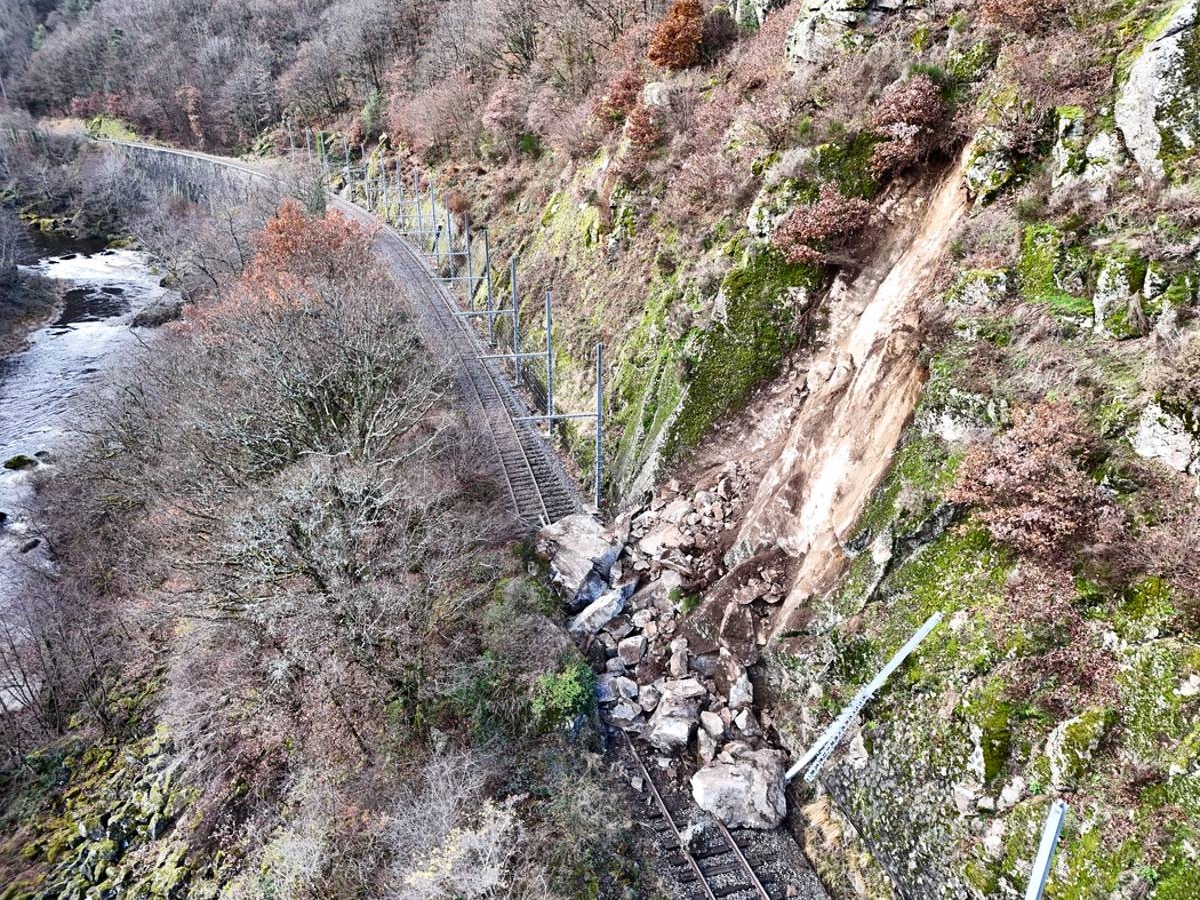
Photos. Above left. Heavy storms on the night of 11/12th July saw power disrupted between Vichy and Saint-Germain-des-Fossés with fallen trees bringing the catenary down. Photo: TER AURA. Above right. Last December's landslide near Monistrol d’Allier on the Ligne de Cevennnes. While clearing and repairing the track is relatively straightforward, stabilising the surrounding cliff-face and high ground is time consuming. Here it took six months, while the Maurrienne Valley rebuilding is likely to be 16 months. Photo: L’eveil de la Haute-Loire/PM.
The maire of Besançon, Anne Vigot, stressed the importance of rail in the local public transport mix. ‘SNCF is our major asset’ she said, whilst urging greater investment to improve rail’s offer as an alternative to the private car. Railways in Doubs département suffered some 3,600min of delay last year, mainly caused by fallen trees and landslips. In March, the Court of Auditors urged SNCF Réseau to equip itself as soon as possible with the tools to anticipate the consequences of climate change, forecast likely costs and deploy appropriate measures. Climate scientist Benjamin Pohl drew on computer modelling to show how dramatically temperatures would rise in Bourgogne-Franche-Comté, with current record highs of around 40degC estimated to rise to 55degC by 2050. Under such conditions he said much of today’s infrastructure would simply fail.
The rail network is already widely impacted by climate events resulting in more frequent landslips, washouts, flooding and damage or deterioration of infrastructure such as power lines, viaducts and cuttings. These events will become increasingly common unless mitigating measures are taken. SNCF Réseau had identified 15 extreme weather events likely to affect the national network in future, but studies by engineering firm SETEC reduced this to five major hazards: very high temperatures, vegetation fires, flooding from overflowing rivers, flooding from rainfall run-off, and infrastructure deformation due to drought or washouts. Two other areas of risk were highlighted: rising sea levels endangering coastal routes, and the effect of severe storms on service quality.
In response, SNCF Réseau has begun to move from reaction to proaction Chabanel said, with three main strategies:
The rail network is already widely impacted by climate events resulting in more frequent landslips, washouts, flooding and damage or deterioration of infrastructure such as power lines, viaducts and cuttings. These events will become increasingly common unless mitigating measures are taken. SNCF Réseau had identified 15 extreme weather events likely to affect the national network in future, but studies by engineering firm SETEC reduced this to five major hazards: very high temperatures, vegetation fires, flooding from overflowing rivers, flooding from rainfall run-off, and infrastructure deformation due to drought or washouts. Two other areas of risk were highlighted: rising sea levels endangering coastal routes, and the effect of severe storms on service quality.
In response, SNCF Réseau has begun to move from reaction to proaction Chabanel said, with three main strategies:
Maintenance and monitoring: Preparing infrastructure to withstand climate risks while developing solutions to better identify them. Simple examples include white painted exteriors which can reduce interior temperature of buildings by up to 5degC, or banning rail welding during very hot weather. Development of digital tools is helping target staff intervention to ensure safe running during severe storms, while some 5,500 sensors are now installed at points and track circuits throughout the network, with more to follow.Infrastructure is increasingly monitored by sensors and other devices to give early warning of fatigue or failure. More fencing will be required following the 2022 ban on glyphosate as unchecked vegetation provides shelter for wild animals, which are then hit by trains causing damage and delay.
Adaptation of assets: Such as design of more resilient components in partnership with suppliers. For example, development of CS2R catenary (Caténaire Simple, Renforcée, Régularisée) with lighter components which are more resilient in high temperatures. This was first installed over the 53km between Tarbes and Montréjeau in 2018 and is replacing first-generation caténaire Midi which often has to be limited to 60km/h running in very high temperatures.
Opposite. A Toulouse – Tarbes TER under CS2R catenary at Tournay. Designed by SNCF Réseau, it comprises two 150mm2 copper contact wires supported by a 116mm2 bronze carrier, simplifying any future upgrading of 1.5kV lines to 25kV.

Adaptation of operating methods: Changes in operating practice to adapt to demand and climatic conditions, often involving crisis management measures such as limiting train speed.
Finally, there was a review of SNCF Renewables’ plans for up to 30% of the railway’s electricity consumption to be generated from solar power by 2030, for a matching reduction of 30% in CO2 emissions.
Finally, there was a review of SNCF Renewables’ plans for up to 30% of the railway’s electricity consumption to be generated from solar power by 2030, for a matching reduction of 30% in CO2 emissions.
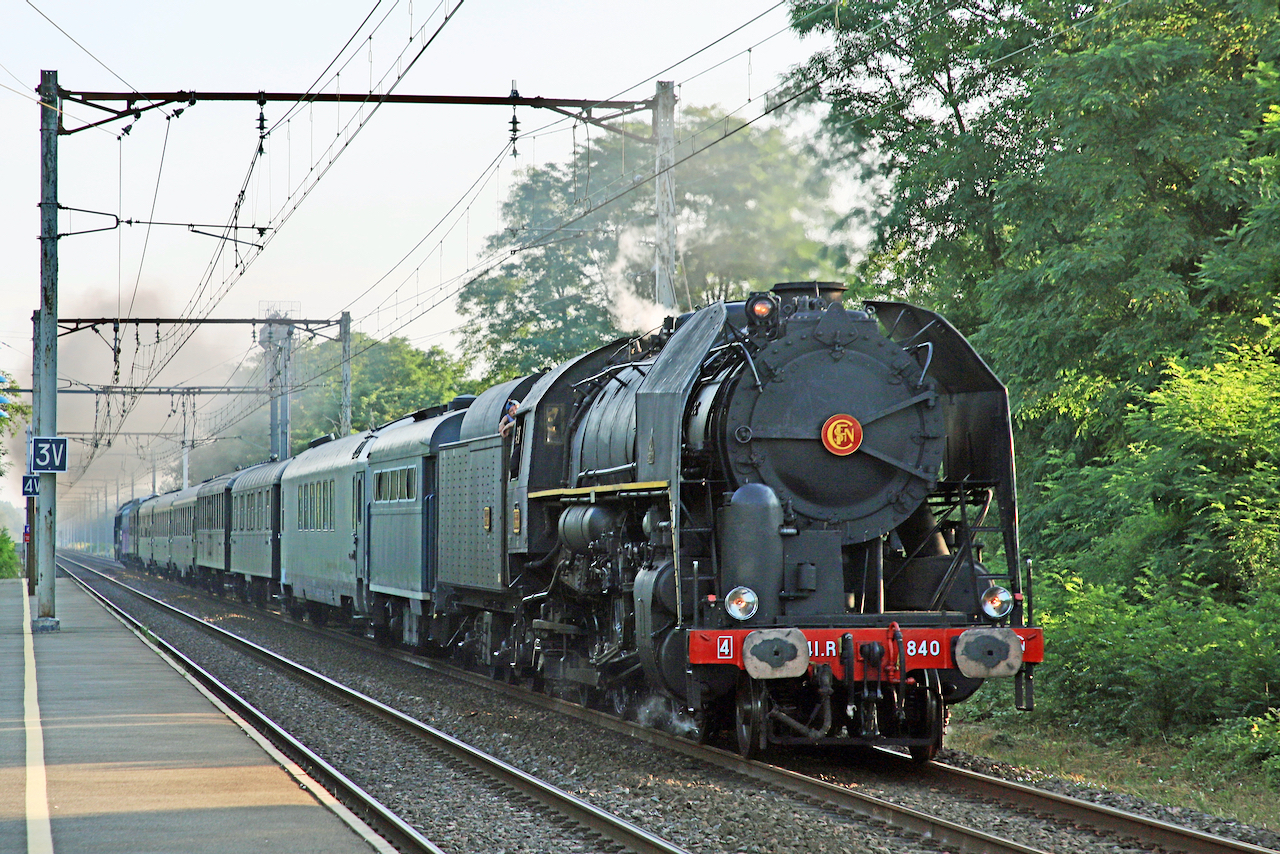
On Saturday 20th July AAATV Centre-Val de Loire ran its first steam tour of the year when 141 R 840 headed from Les Aubrais to Cosne-sur- Loire. Seen above passing Theillay, between Salbris and Vierzon, on the outward journey. Photo: Jocelyne Bourneuf.
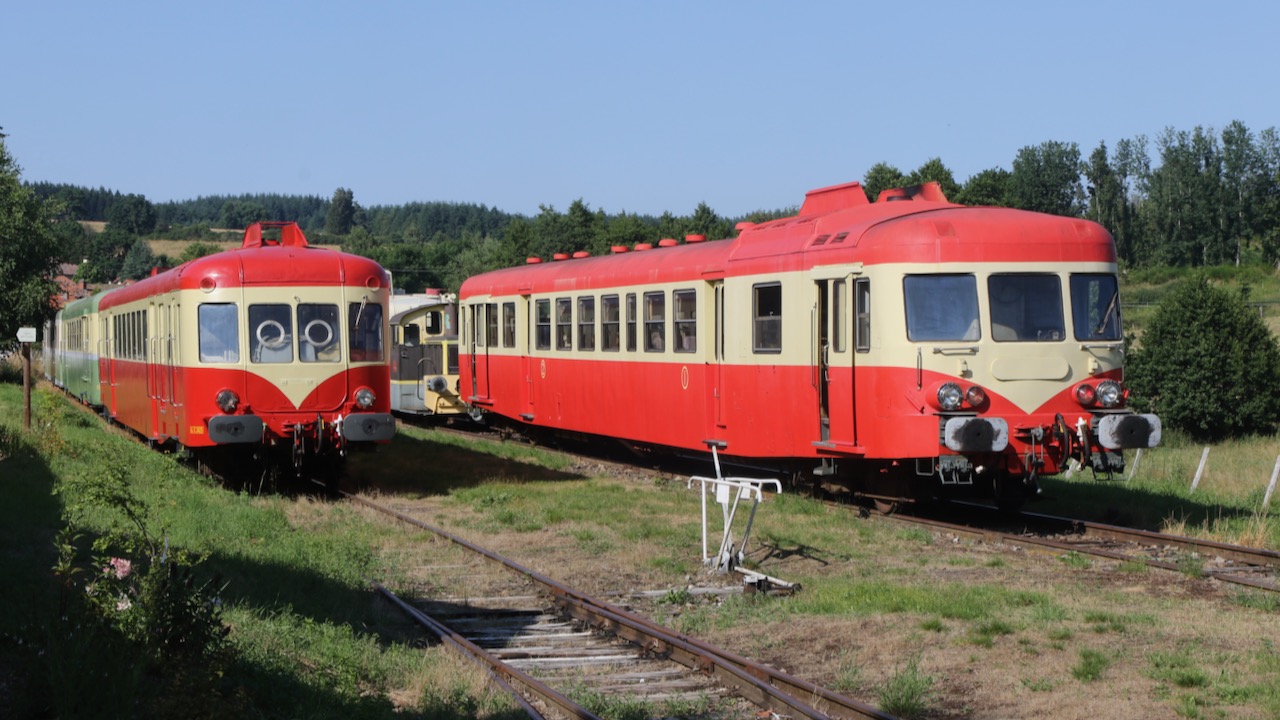
This year Chemin de Fer du Haut-Forez operations between Estivareilles and Craponne-sur-Arzon (21km) on the former Bonson – Sembadel line (closed to passengers 1969) are with a varied railcar fleet: X 2425, X 4001 (both former Quercy Rail and used between Cahors and Capdenac in the late 1990s), and 'Massif Central' X 2807 that has lost its 'Auvergne blue' livery. The three autorails are seen at Estivareilles on the evening of 18th July. Photo: Georges Turpin.
Autorail Fire
A pleasant trundle through the countryside ended abruptly for passengers on the Chemin de Fer Charente Limousine on 25th July when the engine of railcar X2903 caught fire at Les Essarts. None of the 27 passengers was injured but the railcar was damaged. CFCL runs from Roumazières-Loubert on the now-closed western section of the Angoulême – Limoges line to Confolens (17km). Once part of a through route to L’Isle-Jourdain, the line closed to passengers in 1940. Roumazières – Confolens was restored for vélorail service in 1999 and reopened to tourist trains in 2015.
A pleasant trundle through the countryside ended abruptly for passengers on the Chemin de Fer Charente Limousine on 25th July when the engine of railcar X2903 caught fire at Les Essarts. None of the 27 passengers was injured but the railcar was damaged. CFCL runs from Roumazières-Loubert on the now-closed western section of the Angoulême – Limoges line to Confolens (17km). Once part of a through route to L’Isle-Jourdain, the line closed to passengers in 1940. Roumazières – Confolens was restored for vélorail service in 1999 and reopened to tourist trains in 2015.
Photo: Charente Libre/M-FC.
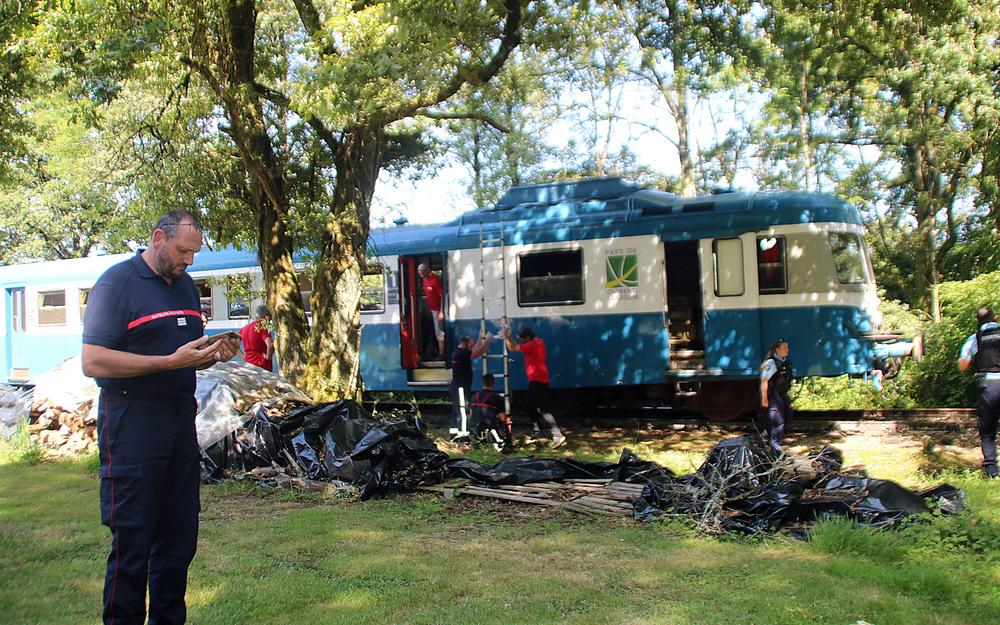
RATP five-year plan
Île-de-France Mobilités adopted the broad outline of the next five-year plan for RATP on 18th June. Investment of €5 billion (excluding rolling stock) in the period 2025 to 2029 is aimed at substantially improving performance and the passenger experience after a long period of public dissatisfaction.
Many improvements will come with commissioning of new-generation metro and RER rolling stock (already ordered), whilst poorly-performing Line 13 will undergo modernisation and automation. Information systems are to be streamlined, with greater emphasis placed on keeping passengers informed during out-of-course events, especially when trains are halted between stations. Harmonisation of information delivery across metro, RER, tram and bus networks is seen as an important element in facilitating multi-mode journeys or directing passengers to another mode when service is disrupted.
Following covid and the recent insect infestation scare, cleanliness and hygiene are increasingly important in public perception. Cleaning of train interiors will be stepped up, toilets provided at more stations, and drinking-water fountains installed to refresh passengers in hot weather. Better maintenance of escalators and lifts will ensure that service is always available for persons with reduced mobility, and more staff will be provided to assist passengers at busy interchanges.
RATP will be offered incentives for punctuality and reliability, service quality and passenger perception, with annual bonuses or penalties according to performance.


RER Line A. From September, peak-hour and evening trains on Fridays and Saturdays will be formed of two sets (Trains Longs) to cope with traffic growth between central Paris and Marne-la-Vallée Chessy, easing congestion for the 1.4 million daily passengers. RATP has contracted Wabtec to equip Line A trains with its Green Friction low-emission brake pads which eliminate up to 90% of harmful dust and particles. All 140 MI 09 trains are to be equipped with the new technology.
Paris T1. ÎdeF Mobilitiés has ordered a further 28 TW20 cars for T1 at a cost of €89 million. Alstom is currently delivering 37 of these Citadis X05 new-generation trams (see June News). The new fleet will enable peak-hour service to be increased from 5 to 4min interval.
RER passenger info. Following trials last year in which 91% of passengers found the service useful, AI-based real-time indication of train loading was extended to RER Lines B, C, D and E in the run-up to the Olympics. Indicators show the loading of individual cars and where space is available. More uniform loading of trains has helped reduce dwell time and thus improve punctuality.
RATP. The proposed five-year reappointment of CEO Jean Castex is in doubt after last month’s dissolution of the National Assembly. Following expiry of his mandate on 23rd July, he remains in post at least until the end of the Olympic Games. His 18-month tenure has seen marked improvement in RATP’s problematic metro and bus services. On the eve of the Games opening ceremony on 26th July, RATP reported over 95% punctuality on all metro lines except for 8 and 13, with Lines 2, 5, 10 and 14 reaching almost 100%.
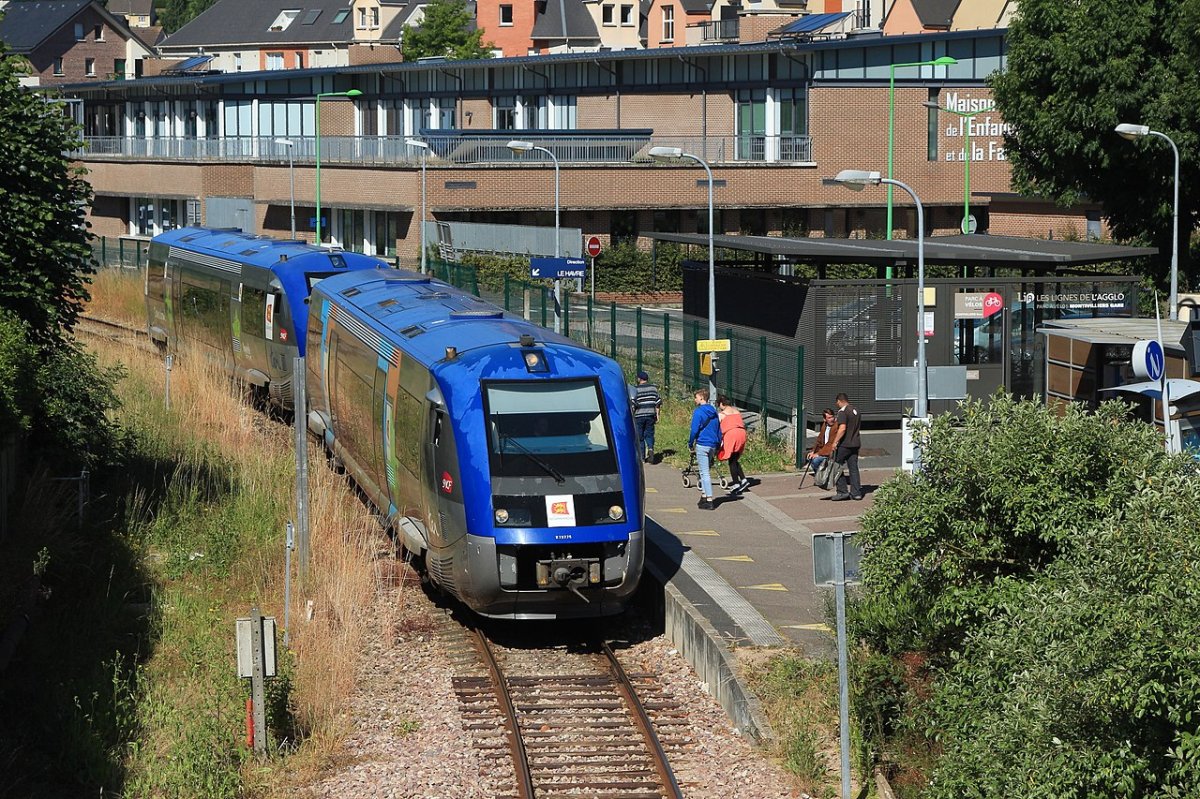
Cap Ferret. The Plage de l’Horizon terminal of Tramway du Cap Ferret is being moved 70m away from the beach to counter erosion due to rising sea levels. Some 20m of the dune have been lost in recent years.

Urbanloop. A commercial demonstration of Nancy’s Urbanloop peoplemover opened on 27th July at the l’île de Loisirsleisure park at Saint-Quentin-en-Yvelines where several Olympic events are taking place. Ten of the two-person ‘capsules’ are running on a 2km track operated by Keolis. Nancy’s 3.5km line is expected to open in 2027.
Photo: L’EstRépublicain/Stephanie Cheffer.
Photo: L’EstRépublicain/Stephanie Cheffer.
Lille. While grappling with the eight-years-late delivery of Alstom’s 52m-long trains for Line 1, the Métropole is planning to order before the end of the year up to 87 trains to replace first-generation stock on Line 2. These 27m sets would enter service in 2026, at the same time as now scheduled for the Line 1 trains.
Asbestos has been found in the undergear of Line 2 trains maintained at Dron and Grand But depots, which have been closed as a precaution. From 9th July, instead of augmented service during the Olympic Games period, Line 2 is operating with fewer trains.
Asbestos has been found in the undergear of Line 2 trains maintained at Dron and Grand But depots, which have been closed as a precaution. From 9th July, instead of augmented service during the Olympic Games period, Line 2 is operating with fewer trains.
Additions to FRS Photographic Archive during July 2024
To Photographic section
- Some thirty-five drawings from Andy Hart’s collection have been added to Folder 2 of the photographic archive
- An article on “Locomotives in France” written by Edouard Sauvage for the “Engineering Times” around 1900 has been added to Folder 7 of the archive
- A new Folder (Folder 12) in the photo archive has been created to hold copies of the FACS-Unecto magazine (which the FRS receives as a complimentary copy); the copies uploaded will be at least 12 months old
- Some 50 B&W images have been added to the “Miscellaneous B&W” gallery Folder 1 (from old Andy Hart files)
- Some 90 Colour images have been added to the “Miscellaneous Colour 2” gallery in Folder 1 (from old Andy Hart files)
- LVDR Special Edition 948/May 1964 - “Exposition Ferroviaire @ Montparnasse”to Folder 7
- LVDR Special Edition Nov 1986 - “Locomotives used during WW1” to Folder 7
- LVDR Special Edition Nov 1986 - “CIWL during WW1” to CIWL gallery in Folder 7
- LVDR 476/Dec 1954 - “Impressionist painters and Chemins de Fer” to Folder 7
- Contract between Lyon Mediterranee and Robert Stephenson May 1855 for locomotives LM 206 & 207 to Folder 7
- Notre Metier no. 2 article on “Ferry-Boat Dunkerque/Douvres” to Folder 7
- Notre Metier no. 2 article on “Locomotive a Chaudiere VELOX” to Folder 7
- Notre Metier no. 1 article on “Gares plus récentes” to Folder 7
- A new gallery of JH Filliette drawings has been created in Folder 2; this includes a variety of grues, locotracteurs, special vehicles and Bugatti autorails
- A new Folder 13 containing 51 plans of railway lines in the Nord & Nord-Est region of France, dating back for the most part to the second half of the last century
- A new Folder 14 containing 18 track plans of stations in the Aisne, Nord & Somme departments
To Locations section - Nil
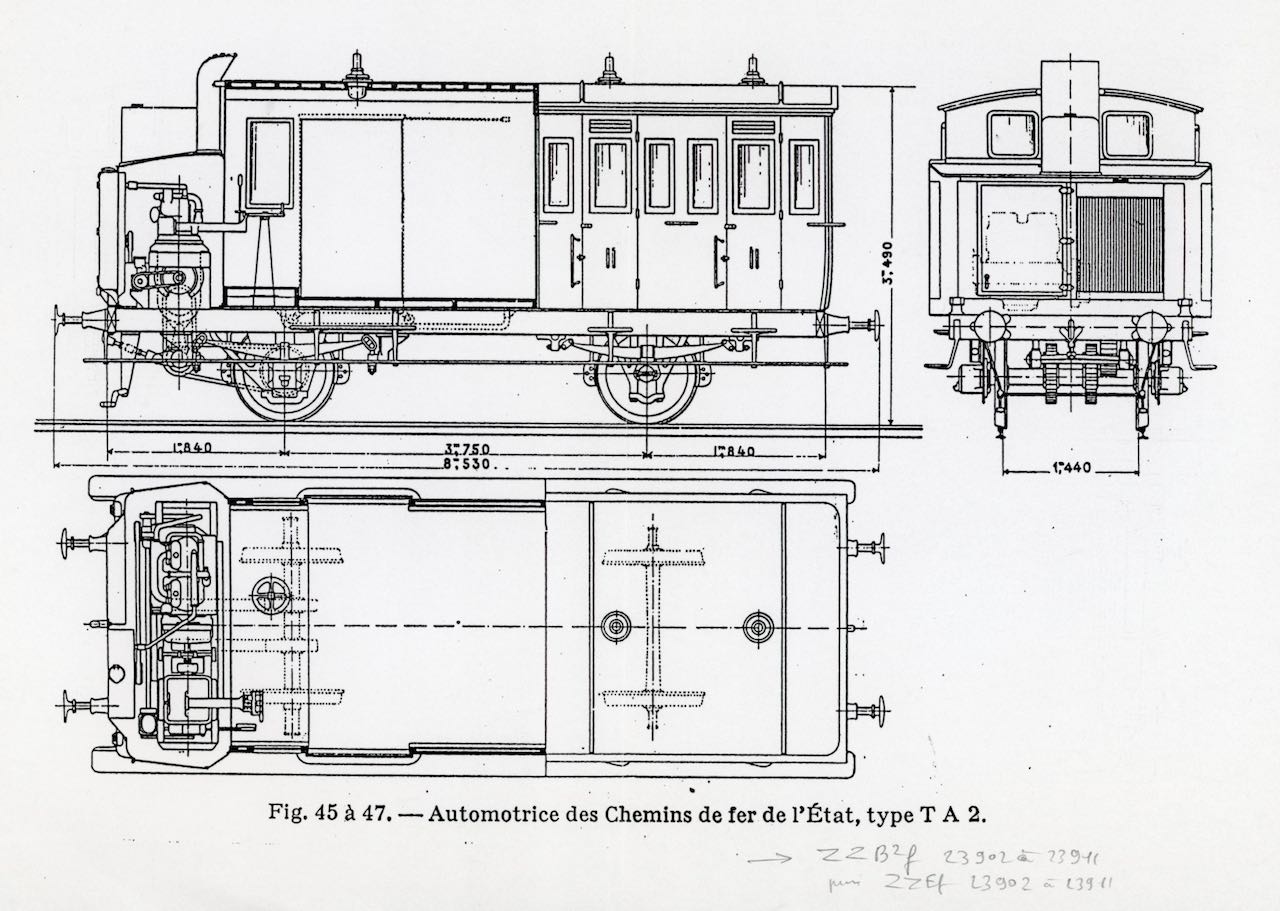
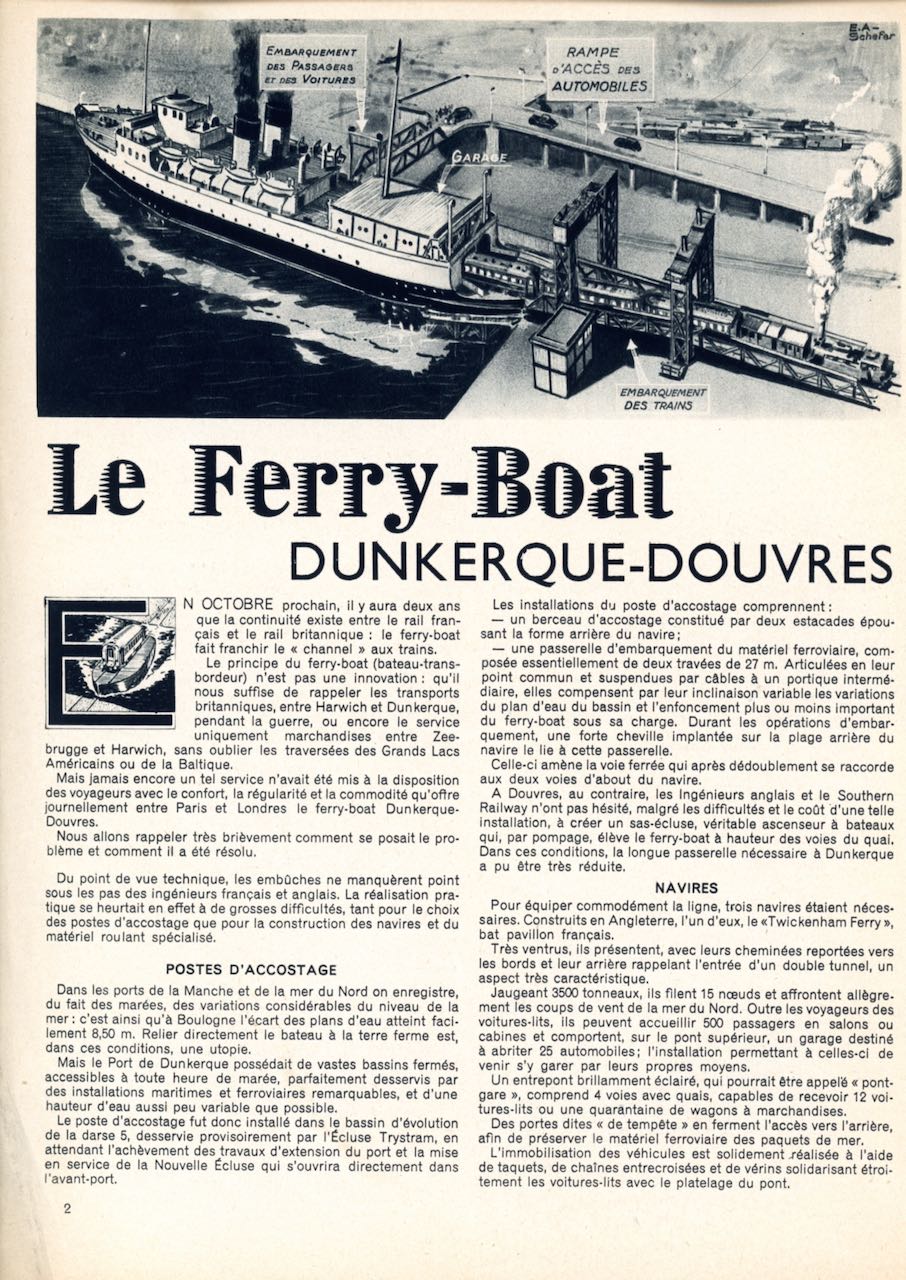
© Peter Lovell & Chris Bushell. The French Railways Society 2024. With thanks to Georges Turpin, Christophe Masse, Jocelyne Bourneuf and David Haydock.
